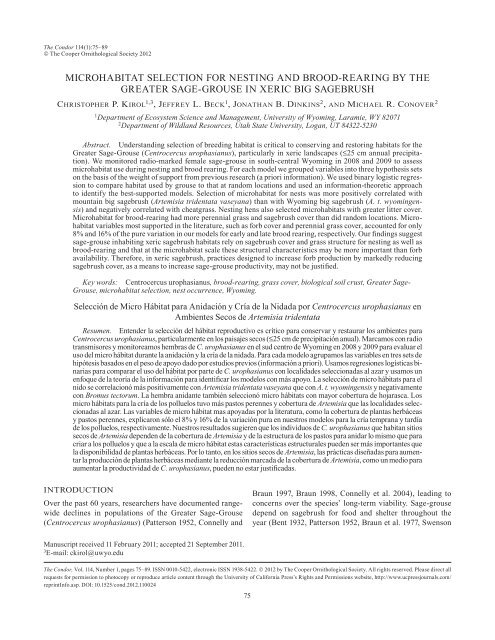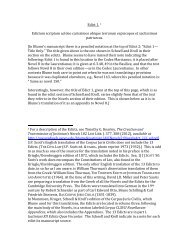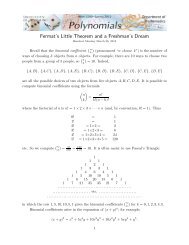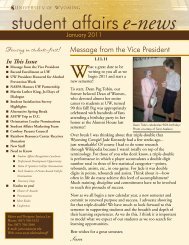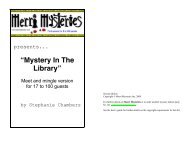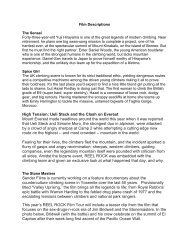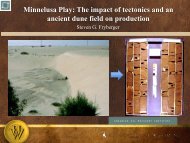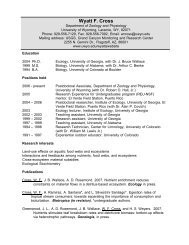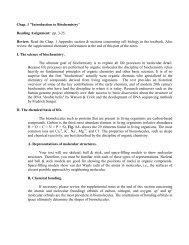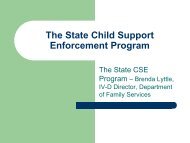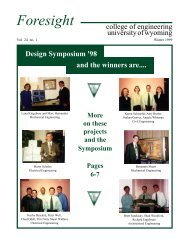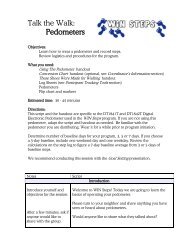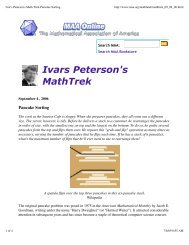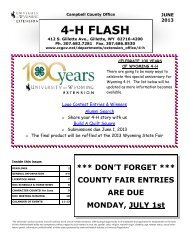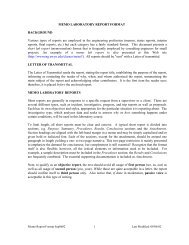microhabitat selection for nesting and brood-rearing by the greater ...
microhabitat selection for nesting and brood-rearing by the greater ...
microhabitat selection for nesting and brood-rearing by the greater ...
You also want an ePaper? Increase the reach of your titles
YUMPU automatically turns print PDFs into web optimized ePapers that Google loves.
The Condor 114(1):75–89<br />
© The Cooper Ornithological Society 2012<br />
MICROHABITAT SELECTION FOR NESTING AND BROOD-REARING BY THE<br />
GREATER SAGE-GROUSE IN XERIC BIG SAGEBRUSH<br />
Christopher p. Kirol 1,3 , Jeffrey l. BeCK 1 , Jonathan B. DinKins 2 , anD MiChael r. Conover 2<br />
1 Department of Ecosystem Science <strong>and</strong> Management, University of Wyoming, Laramie, WY 82071<br />
2 Department of Wildl<strong>and</strong> Resources, Utah State University, Logan, UT 84322-5230<br />
Abstract. Underst<strong>and</strong>ing <strong>selection</strong> of breeding habitat is critical to conserving <strong>and</strong> restoring habitats <strong>for</strong> <strong>the</strong><br />
Greater Sage-Grouse (Centrocercus urophasianus), particularly in xeric l<strong>and</strong>scapes (≤25 cm annual precipitation).<br />
We monitored radio-marked female sage-grouse in south-central Wyoming in 2008 <strong>and</strong> 2009 to assess<br />
<strong>microhabitat</strong> use during <strong>nesting</strong> <strong>and</strong> <strong>brood</strong> <strong>rearing</strong>. For each model we grouped variables into three hypo<strong>the</strong>sis sets<br />
on <strong>the</strong> basis of <strong>the</strong> weight of support from previous research (a priori in<strong>for</strong>mation). We used binary logistic regression<br />
to compare habitat used <strong>by</strong> grouse to that at r<strong>and</strong>om locations <strong>and</strong> used an in<strong>for</strong>mation-<strong>the</strong>oretic approach<br />
to identify <strong>the</strong> best-supported models. Selection of <strong>microhabitat</strong> <strong>for</strong> nests was more positively correlated with<br />
mountain big sagebrush (Artemisia tridentata vaseyana) than with Wyoming big sagebrush (A. t. wyomingensis)<br />
<strong>and</strong> negatively correlated with cheatgrass. Nesting hens also selected <strong>microhabitat</strong>s with <strong>greater</strong> litter cover.<br />
Microhabitat <strong>for</strong> <strong>brood</strong>-<strong>rearing</strong> had more perennial grass <strong>and</strong> sagebrush cover than did r<strong>and</strong>om locations. Microhabitat<br />
variables most supported in <strong>the</strong> literature, such as <strong>for</strong>b cover <strong>and</strong> perennial grass cover, accounted <strong>for</strong> only<br />
8% <strong>and</strong> 16% of <strong>the</strong> pure variation in our models <strong>for</strong> early <strong>and</strong> late <strong>brood</strong> <strong>rearing</strong>, respectively. Our findings suggest<br />
sage-grouse inhabiting xeric sagebrush habitats rely on sagebrush cover <strong>and</strong> grass structure <strong>for</strong> <strong>nesting</strong> as well as<br />
<strong>brood</strong>-<strong>rearing</strong> <strong>and</strong> that at <strong>the</strong> <strong>microhabitat</strong> scale <strong>the</strong>se structural characteristics may be more important than <strong>for</strong>b<br />
availability. There<strong>for</strong>e, in xeric sagebrush, practices designed to increase <strong>for</strong>b production <strong>by</strong> markedly reducing<br />
sagebrush cover, as a means to increase sage-grouse productivity, may not be justified.<br />
Key words: Centrocercus urophasianus, <strong>brood</strong>-<strong>rearing</strong>, grass cover, biological soil crust, Greater Sage-<br />
Grouse, <strong>microhabitat</strong> <strong>selection</strong>, nest occurrence, Wyoming.<br />
Selección de Micro Hábitat para Anidación y Cría de la Nidada por Centrocercus urophasianus en<br />
Ambientes Secos de Artemisia tridentata<br />
Resumen. Entender la selección del hábitat reproductivo es crítico para conservar y restaurar los ambientes para<br />
Centrocercus urophasianus, particularmente en los paisajes secos (≤25 cm de precipitación anual). Marcamos con radio<br />
transmisores y monitoreamos hembras de C. urophasianus en el sud centro de Wyoming en 2008 y 2009 para evaluar el<br />
uso del micro hábitat durante la anidación y la cría de la nidada. Para cada modelo agrupamos las variables en tres sets de<br />
hipótesis basados en el peso de apoyo dado por estudios previos (in<strong>for</strong>mación a priori). Usamos regresiones logísticas binarias<br />
para comparar el uso del hábitat por parte de C. urophasianus con localidades seleccionadas al azar y usamos un<br />
enfoque de la teoría de la in<strong>for</strong>mación para identificar los modelos con más apoyo. La selección de micro hábitats para el<br />
nido se correlacionó más positivamente con Artemisia tridentata vaseyana que con A. t. wyomingensis y negativamente<br />
con Bromus tectorum. La hembra anidante también seleccionó micro hábitats con mayor cobertura de hojarasca. Los<br />
micro hábitats para la cría de los polluelos tuvo más pastos perennes y cobertura de Artemisia que las localidades seleccionadas<br />
al azar. Las variables de micro hábitat mas apoyadas por la literatura, como la cobertura de plantas herbáceas<br />
y pastos perennes, explicaron sólo el 8% y 16% de la variación pura en nuestros modelos para la cría temprana y tardía<br />
de los polluelos, respectivamente. Nuestros resultados sugieren que los individuos de C. urophasianus que habitan sitios<br />
secos de Artemisia dependen de la cobertura de Artemisia y de la estructura de los pastos para anidar lo mismo que para<br />
criar a los polluelos y que a la escala de micro hábitat estas características estructurales pueden ser más importantes que<br />
la disponibilidad de plantas herbáceas. Por lo tanto, en los sitios secos de Artemisia, las prácticas diseñadas para aumentar<br />
la producción de plantas herbáceas mediante la reducción marcada de la cobertura de Artemisia, como un medio para<br />
aumentar la productividad de C. urophasianus, pueden no estar justificadas.<br />
INTRODUCTION<br />
Over <strong>the</strong> past 60 years, researchers have documented rangewide<br />
declines in populations of <strong>the</strong> Greater Sage-Grouse<br />
(Centrocercus urophasianus) (Patterson 1952, Connelly <strong>and</strong><br />
Manuscript received 11 February 2011; accepted 21 September 2011.<br />
3E-mail: ckirol@uwyo.edu<br />
The Condor, Vol. 114, Number 1, pages 75–89. ISSN 0010-5422, electronic ISSN 1938-5422. © 2012 <strong>by</strong> The Cooper Ornithological Society. All rights reserved. Please direct all<br />
requests <strong>for</strong> permission to photocopy or reproduce article content through <strong>the</strong> University of Cali<strong>for</strong>nia Press’s Rights <strong>and</strong> Permissions website, http://www.ucpressjournals.com/<br />
reprintInfo.asp. DOI: 10.1525/cond.2012.110024<br />
75<br />
Braun 1997, Braun 1998, Connelly et al. 2004), leading to<br />
concerns over <strong>the</strong> species’ long-term viability. Sage-grouse<br />
depend on sagebrush <strong>for</strong> food <strong>and</strong> shelter throughout <strong>the</strong><br />
year (Bent 1932, Patterson 1952, Braun et al. 1977, Swenson
76 CHRISTOPHER P. KIROL et al.<br />
1987, Connelly et al. 2011). Extensive loss <strong>and</strong> fragmentation<br />
of big sagebrush (Artemisia tridentata) steppe have reduced<br />
<strong>the</strong> current distribution of sage-grouse to about one-half of its<br />
original extent (Schroeder et al. 2004). Knowing what vegetation<br />
<strong>and</strong> structural characteristics at <strong>the</strong> <strong>microhabitat</strong> scale are<br />
important to sage-grouse at each stage of <strong>the</strong>ir breeding cycle<br />
is critical to maintaining <strong>and</strong> restoring habitat on <strong>the</strong> remaining<br />
l<strong>and</strong>s supporting sage-grouse.<br />
Research has exp<strong>and</strong>ed our ecological underst<strong>and</strong>ing of<br />
<strong>the</strong> sage-grouse’s <strong>selection</strong> of <strong>nesting</strong> habitat at <strong>the</strong> <strong>microhabitat</strong><br />
scale (e.g., Dunn <strong>and</strong> Braun 1986, Sveum et al. 1998b,<br />
Connelly et al. 2000, Aldridge <strong>and</strong> Brigham 2002, Holloran<br />
et al. 2005, Kaczor 2008, Doherty et al. 2010). Studies have<br />
documented <strong>the</strong> importance of specific habitat features,<br />
including adequate sagebrush cover (or shrub cover) <strong>and</strong> sagebrush<br />
height (Wallestad <strong>and</strong> Pyrah 1974, Fischer 1994, Sveum<br />
et al. 1998b, Connelly et al. 2000, Braun et al. 2005, Holloran<br />
et al. 2005, Hagen et al. 2007, Kaczor 2008), as well as an herbaceous<br />
understory (Lyon 2000, Holloran et al. 2005, Hagen<br />
et al. 2007).<br />
Microhabitats <strong>for</strong> <strong>nesting</strong> <strong>and</strong> early <strong>brood</strong> <strong>rearing</strong> often<br />
are very similar because <strong>brood</strong>ing females spend <strong>the</strong>ir first<br />
2–3 weeks after <strong>the</strong> eggs hatch in <strong>the</strong> vicinity of <strong>the</strong>ir nest<br />
(Berry <strong>and</strong> Eng 1985, Holloran <strong>and</strong> Anderson 2005). Sagegrouse<br />
chicks eat foods with high protein content (i.e., insects<br />
<strong>and</strong> actively growing <strong>for</strong>bs) almost exclusively <strong>for</strong> <strong>the</strong> first 2<br />
weeks after hatching (Johnson <strong>and</strong> Boyce 1990); as a result,<br />
<strong>the</strong> hen likely selects habitats <strong>for</strong> early <strong>brood</strong>-<strong>rearing</strong> on <strong>the</strong><br />
basis of abundance of insects <strong>and</strong> protein-rich <strong>for</strong>bs (Barnett<br />
<strong>and</strong> Craw<strong>for</strong>d 1994, Holloran <strong>and</strong> Anderson 2004). Generally,<br />
<strong>the</strong>se habitats are characterized <strong>by</strong> a well-developed sagebrush<br />
overstory <strong>and</strong> a healthy herbaceous understory (Connelly et<br />
al. 2000). Sage-grouse chicks consume fewer insects as <strong>the</strong><br />
summer progresses, <strong>and</strong> <strong>for</strong>bs <strong>for</strong>m a larger portion of <strong>the</strong>ir<br />
diets (Klebenow <strong>and</strong> Gray 1968, Peterson 1970). Research has<br />
suggested that late <strong>brood</strong>-<strong>rearing</strong> habitat is generally associated<br />
with more mesic sites that provide <strong>greater</strong> quantities of<br />
<strong>for</strong>bs <strong>and</strong> insects <strong>for</strong> both hens <strong>and</strong> chicks (Schroeder et al.<br />
1999, Connelly et al. 2000). Because of <strong>the</strong> demonstrated importance<br />
of <strong>for</strong>bs to <strong>brood</strong>ing hens <strong>and</strong> chicks, conservation<br />
ef<strong>for</strong>ts commonly focus on habitat treatments in which sagebrush<br />
is removed to increase <strong>for</strong>b production (Wrobleski <strong>and</strong><br />
Kauffman 2003, Pyke 2011).<br />
Habitat-<strong>selection</strong> analyses are commonly used to identify<br />
resources that are used disproportionately to <strong>the</strong>ir availability<br />
(Millspaugh <strong>and</strong> Marzluff 2001), predicated on <strong>the</strong> idea that<br />
animals are making choices (i.e., habitat <strong>selection</strong>; Garshelis<br />
2000). Thus, it reasons that <strong>the</strong>se choices are influenced <strong>by</strong><br />
habitat conditions at specific locations within a species’ range.<br />
Our underst<strong>and</strong>ing of <strong>the</strong> sage-grouse’s <strong>selection</strong> of habitat<br />
<strong>for</strong> <strong>nesting</strong> <strong>and</strong> <strong>brood</strong> <strong>rearing</strong> comes primarily from studies<br />
in habitats more mesic (e.g., Drutt 1992, Holloran 1999,<br />
Lyon 2000, Aldridge <strong>and</strong> Brigham 2002, Hausleitner 2003,<br />
Slater 2003, Aldridge 2005, Doherty et al. 2010) than those<br />
found in our study areas, where precipitation averages 23.0 cm<br />
annually, on <strong>the</strong> basis of ≥21 years of data compiled from four<br />
surrounding meteorological stations (Western Regional Climate<br />
Center 2010).<br />
Our primary objective was to explore <strong>microhabitat</strong><br />
<strong>selection</strong>, considering both physiognomic <strong>and</strong> floristic characteristics,<br />
during <strong>nesting</strong>, early <strong>brood</strong> <strong>rearing</strong>, <strong>and</strong> late<br />
<strong>brood</strong> <strong>rearing</strong> in south-central Wyoming. We hypo<strong>the</strong>sized<br />
that <strong>the</strong> <strong>microhabitat</strong> variables most predictive of <strong>selection</strong><br />
in our drier study areas may diverge from findings in more<br />
mesic areas. We were able to gain insight into this question<br />
with sequential modeling (Arnold 2010) <strong>by</strong> defining categories<br />
of models, termed hypo<strong>the</strong>sis sets, <strong>for</strong> each life stage on<br />
<strong>the</strong> basis of a priori in<strong>for</strong>mation to select <strong>the</strong> best-supported<br />
models. On <strong>the</strong> basis of <strong>the</strong> weight of evidence in published<br />
literature on habitat <strong>selection</strong> during <strong>the</strong> reproductive period<br />
<strong>and</strong> sage-grouse biology we grouped <strong>microhabitat</strong> variables<br />
into three hypo<strong>the</strong>sis sets.<br />
METHODS<br />
STUDY AREAS<br />
The Atlantic Rim (AR) <strong>and</strong> Stewart Creek (SC) study areas<br />
are located in south-central Wyoming within a semi-desert<br />
grass–shrub zone characterized <strong>by</strong> expansive sagebrush steppe<br />
with low average annual precipitation (Natural Resources Conservation<br />
Service 2006). Combined, <strong>the</strong> study areas encompass<br />
approximately 1913 km² (AR = 1093 km² <strong>and</strong> SC = 820 km²) at<br />
elevations ranging from 1981 to 2529 m. The majority of l<strong>and</strong><br />
in both areas is owned <strong>and</strong> administered <strong>by</strong> <strong>the</strong> U.S. Bureau of<br />
L<strong>and</strong> Management. Grazing of cattle <strong>and</strong> domestic sheep is a<br />
major l<strong>and</strong> use in both areas. The AR is also being developed<br />
<strong>for</strong> extraction of natural gas from coal beds. Both study areas<br />
are dominated <strong>by</strong> Wyoming big sagebrush (A. t. wyomingensis)<br />
at lower elevations <strong>and</strong> mountain big sagebrush (A. t. vaseyana)<br />
along foothills at higher elevations (BLM 2006b). Common<br />
<strong>for</strong>bs composing <strong>the</strong> understory include arrowleaf balsamroot<br />
(Balsamorhiza sagittata), desert parsley (Cymopterus spp.),<br />
phlox (Phlox spp.), sego lily (Calochortus nuttallianum), sulfur<br />
buckwheat (Eriogonum umbellatum), <strong>and</strong> wild onion (Allium<br />
spp.). Common grasses include bluebunch wheatgrass (Pseudoroegneria<br />
spicata), green needlegrass (Nassella viridula),<br />
needle <strong>and</strong> thread (Hesperostipa comata), prairie junegrass<br />
(Koeleria macrantha), <strong>and</strong> western wheatgrass (Pascopyrum<br />
smithii; BLM 2006a).<br />
RADIO-MARKING AND MONITORING SAGE-GROUSE<br />
We captured female sage-grouse from mid-March through<br />
late April 2008 <strong>and</strong> 2009 on or near 14 leks in <strong>the</strong> AR <strong>and</strong><br />
5 leks in <strong>the</strong> SC <strong>by</strong> established spot-lighting <strong>and</strong> hoop-netting<br />
protocols (Giesen et al. 1982, Wakkinen et al. 1992). To ensure<br />
equal capture ef<strong>for</strong>t <strong>and</strong> to obtain a r<strong>and</strong>om sample of<br />
<strong>the</strong> population (Manly et al. 2002), we selected leks evenly<br />
distributed across both study areas. We secured VHF radio
SAGE-GROUSE NESTING AND BROOD-REARING IN XERIC MICROHABITAT 77<br />
transmitters (Model A4060; Advanced Telemetry Systems,<br />
Isanti, MN) to females with a PVC-covered wire necklace.<br />
Transmitters weighed 22 g (~1.4% of a female sage-grouses’<br />
mean body mass); had a battery with a life expectancy of 789<br />
days, <strong>and</strong> were equipped with motion sensors (<strong>the</strong> transmitter’s<br />
pulse rate increased in response to inactivity after 8 hr).<br />
Using h<strong>and</strong>-held receivers <strong>and</strong> 3-element Yagi antennas,<br />
we located sage-grouse weekly through <strong>nesting</strong> (May–June)<br />
<strong>and</strong> <strong>brood</strong> <strong>rearing</strong> (late June–August) mainly between <strong>the</strong><br />
hours of 08:00 <strong>and</strong> 18:00. We located <strong>the</strong> nests <strong>and</strong> <strong>brood</strong>s<br />
of radio-marked birds <strong>by</strong> circling <strong>the</strong> signal’s source until <strong>the</strong><br />
surveyor saw <strong>the</strong> bird on a nest or with her <strong>brood</strong> or isolated<br />
<strong>the</strong> nest or <strong>brood</strong> to a few shrubs. After determining a female<br />
grouse was <strong>nesting</strong>, we monitored <strong>the</strong> nest biweekly until <strong>the</strong><br />
conclusion of <strong>the</strong> <strong>nesting</strong> ef<strong>for</strong>t. We left nests in a me<strong>and</strong>ering<br />
or zigzag pattern to reduce <strong>the</strong> potential of predators following<br />
human scent to <strong>the</strong> nest. To fur<strong>the</strong>r minimize humaninduced<br />
nest predation or nest ab<strong>and</strong>onment, we monitored<br />
incubating females from a distance of ≥30 m <strong>by</strong> triangulating<br />
to <strong>the</strong> exact nest point or nest shrub. At each visit to a possibly<br />
<strong>brood</strong>ing hen, we attempted to determine if <strong>the</strong> female<br />
was still with chicks <strong>by</strong> sighting <strong>the</strong> chicks with binoculars or<br />
<strong>by</strong> observing <strong>the</strong> <strong>brood</strong>ing female’s behavior (e.g., distraction<br />
displays, feigning injury, clucking, <strong>and</strong> hesitation to flush).<br />
We recorded <strong>the</strong> locations of nests <strong>and</strong> <strong>brood</strong>s (± 1 m) with a<br />
h<strong>and</strong>-held 12-channel global positioning system (GPS; Garmin<br />
Etrex; Garmin International, Ola<strong>the</strong>, KS).<br />
We established locations <strong>for</strong> r<strong>and</strong>om sampling <strong>by</strong> using<br />
a Geographic In<strong>for</strong>mation System (GIS) to generate a 1-km 2<br />
grid overlaying <strong>the</strong> two study areas. We numbered, <strong>the</strong>n r<strong>and</strong>omized<br />
<strong>the</strong> intersection points to represent sampling locations<br />
(r<strong>and</strong>om locations) <strong>and</strong> employed <strong>the</strong> Northwest GAP<br />
l<strong>and</strong>-cover data (2008) to constrain <strong>the</strong> r<strong>and</strong>om locations to<br />
sagebrush habitats while excluding areas of inappropriate<br />
habitat such as exposed rock, open water, <strong>and</strong> conifer st<strong>and</strong>s.<br />
MICROHABITAT MEASUREMENTS<br />
We used established protocols to measure <strong>the</strong> vegetative characteristics<br />
of <strong>the</strong> <strong>microhabitat</strong> surrounding nests, <strong>brood</strong>s,<br />
<strong>and</strong> r<strong>and</strong>om locations (Connelly et al. 2003). To sample<br />
characteristics within 5 <strong>and</strong> 10 m of each nest <strong>and</strong> <strong>brood</strong>,<br />
respectively, we measured <strong>microhabitat</strong> characteristics along<br />
two perpendicular 10-m surveyor tapes centered on nests <strong>and</strong><br />
r<strong>and</strong>om locations (Gregg et al. 1994) <strong>and</strong> two perpendicular<br />
20-m surveyor tapes centered on locations of <strong>brood</strong>s <strong>and</strong><br />
r<strong>and</strong>om locations (K. P. Reese, pers. comm., 2008). We recorded<br />
general habitat characteristics at nests including vegetation<br />
association after hatching in late May <strong>and</strong> June <strong>and</strong><br />
concluded our measurements at nest <strong>and</strong> r<strong>and</strong>om locations in<br />
early July. At locations of <strong>brood</strong>s <strong>and</strong> r<strong>and</strong>om locations we<br />
recorded <strong>microhabitat</strong> characteristics in July <strong>and</strong> August. We<br />
measured <strong>microhabitat</strong> characteristics at locations grouse<br />
used <strong>and</strong> at r<strong>and</strong>om locations concurrently. We considered<br />
<strong>the</strong> early <strong>brood</strong> period to last from hatch to 14 days (Connelly<br />
et al. 1988, Thompson et al. 2006) <strong>and</strong> so recorded habitat<br />
characteristics <strong>for</strong> early <strong>brood</strong> <strong>rearing</strong> at one location occupied<br />
<strong>by</strong> each <strong>brood</strong> during this period. For late <strong>brood</strong> <strong>rearing</strong><br />
we recorded habitat characteristics at one location occupied<br />
<strong>by</strong> each <strong>brood</strong> when <strong>the</strong> chicks were approximately 20 to<br />
30 days old (Connelly et al. 1988, Connelly et al. 2011).<br />
We determined <strong>the</strong> location of a simulated nest site<br />
(r<strong>and</strong>om) <strong>by</strong> selecting <strong>the</strong> closest shrub taller than or equal<br />
to 30 cm, <strong>the</strong> average height of nest shrubs in Wyoming<br />
(Patterson 1952, Holloran et al. 2005). We did not follow this<br />
convention to establish r<strong>and</strong>om locations <strong>for</strong> comparison<br />
with <strong>brood</strong>-<strong>rearing</strong> because hens with chicks select a variety<br />
of vegetation, including shrubs, grasses, <strong>and</strong> <strong>for</strong>bs. At each<br />
location, we measured a suite of physiognomic <strong>and</strong> floristic<br />
(Rotenberry 1985) <strong>microhabitat</strong> variables quantifying <strong>the</strong><br />
overstory, understory, <strong>and</strong> ground cover (Table 1).<br />
We used <strong>the</strong> line-intercept technique (Canfield 1941)<br />
to quantify shrub canopy cover <strong>by</strong> species at each location<br />
(Wambolt et al. 2006). We measured height (cm) of each sagebrush<br />
or o<strong>the</strong>r shrub (tallest leader, excluding inflorescences)<br />
encountered along <strong>the</strong> line <strong>and</strong> averaged <strong>the</strong>se per location.<br />
The average height of sagebrush included several taxa but<br />
consisted mainly of mountain <strong>and</strong> Wyoming big sagebrush<br />
<strong>and</strong>, on occasion, basin big sagebrush (A. t. tridentata) <strong>and</strong><br />
silver sagebrush (A. cana), but it excluded mat-<strong>for</strong>ming subshrub<br />
species including fringed sagebrush (A. frigida) <strong>and</strong><br />
birdfoot sagebrush (A. pedatifida). We quantified shrub density<br />
as <strong>the</strong> number of shrubs rooted in a belt transect 1 m wide<br />
along each line transect. To distinguish Wyoming <strong>and</strong> mountain<br />
big sagebrush accurately, we took a representative sample<br />
at each location <strong>and</strong> identified <strong>the</strong>m to subspecies with a<br />
UV-light fluorescence test (Rosentreter 2005). We estimated<br />
visual obstruction with a 1-m modified Robel pole (diameter<br />
3 cm; Robel et al. 1970, Griffith <strong>and</strong> Youtie 1988) placed in <strong>the</strong><br />
center of each location (nest bowl or center of <strong>brood</strong> locations<br />
or r<strong>and</strong>om locations) <strong>and</strong> recorded measurements from each<br />
cardinal direction. We estimated <strong>the</strong> canopy or ground cover<br />
of invasive annual grasses, perennial grasses, residual perennial<br />
grasses, <strong>for</strong>b cover, food <strong>for</strong>b cover, gravel <strong>and</strong> rock, bare<br />
soil, biological soil crust, <strong>and</strong> litter within six cover classes<br />
in quadrats of 20 × 50 cm (0.1 m 2 ; Daubenmire 1959) placed<br />
along each surveyors’ tape (nest: transect intersection, 2 m,<br />
4 m, 6 m, <strong>and</strong> 8 m; <strong>brood</strong>: transect intersection, 4 m, 6 m, 8 m,<br />
10 m, 12 m, <strong>and</strong> 14 m) <strong>and</strong> radiating from <strong>the</strong> transect intersection.<br />
This yielded nine quadrats per location <strong>for</strong> each nest<br />
or simulated nest <strong>and</strong> 13 <strong>for</strong> each <strong>brood</strong> or simulated <strong>brood</strong>.<br />
We defined cover classes as 1 = 0–1%, 2 = 1.1–5%, 3 = 5.1–<br />
25%, 4 = 25.1–50%, 5 = 50.1–75%, <strong>and</strong> 6 = 75.1–100%. We<br />
grouped <strong>for</strong>bs that are known to be eaten <strong>by</strong> sage-grouse (Patterson<br />
1952, Peterson 1970, Wallestad <strong>and</strong> Eng 1975, Barnett<br />
<strong>and</strong> Craw<strong>for</strong>d 1994) as food <strong>for</strong>bs (Table 2) <strong>and</strong> o<strong>the</strong>rs as nonfood<br />
<strong>for</strong>bs. We measured <strong>the</strong> heights of residual <strong>and</strong> perennial<br />
grasses (cm) as <strong>the</strong> tallest naturally growing portion of<br />
<strong>the</strong> plant excluding flowering stalks (droop height) within 1 m
78 CHRISTOPHER P. KIROL et al.<br />
TABLE 1. Microhabitat characteristics measured at nest sites, locations of early <strong>and</strong> late <strong>brood</strong> <strong>rearing</strong>, <strong>and</strong> r<strong>and</strong>om locations,<br />
south-central Wyoming, 2008 <strong>and</strong> 2009.<br />
Variable Description<br />
of each Daubenmire quadrat to yield 9 or 13 height measurements<br />
<strong>for</strong> each <strong>microhabitat</strong> location.<br />
EXPERIMENTAL DESIGN AND DATA ANALYSIS<br />
We employed a use-versus-availability design to evaluate<br />
fourth-order habitat <strong>selection</strong>, or <strong>selection</strong> of items from<br />
a habitat patch (e.g., a nest site; Johnson 1980, Manly et al.<br />
2002). We pooled locations individual grouse use locations<br />
to represent a population-level response (i.e., type I design of<br />
Thomas <strong>and</strong> Taylor 2006; Manly et al. 2002). R<strong>and</strong>om locations<br />
were also pooled <strong>and</strong> constrained within <strong>the</strong> boundaries<br />
of each study area (Manly et al. 2002).<br />
For statistical analyses we used SAS version 9.2 (SAS<br />
Institute 2009). We evaluated <strong>microhabitat</strong> <strong>selection</strong> with<br />
binary logistic regression modeling. For each period (<strong>nesting</strong>,<br />
early <strong>brood</strong> <strong>rearing</strong>, <strong>and</strong> late <strong>brood</strong> <strong>rearing</strong>), we determined<br />
<strong>the</strong> probability of use where used (e.g., early <strong>brood</strong>-<strong>rearing</strong><br />
locations) <strong>and</strong> available locations (e.g., r<strong>and</strong>om locations) were<br />
<strong>the</strong> dependent variables (Johnson et al. 2006). We did not define<br />
r<strong>and</strong>om locations, representing available habitat, as unused<br />
resources because <strong>the</strong> absence of a nest or <strong>brood</strong>ing female cannot<br />
be determined without error (i.e., we are not certain that <strong>the</strong><br />
r<strong>and</strong>om locations were all unused). However, we excluded r<strong>and</strong>om<br />
locations that had evidence of <strong>nesting</strong> or <strong>brood</strong> <strong>rearing</strong>, so<br />
contamination was likely negligible (Johnson et al. 2006).<br />
Prior to modeling, we computed a Pearson’s correlation<br />
matrix to test <strong>for</strong> multicollinearity among <strong>the</strong> variables<br />
(linear dependencies among <strong>the</strong> explanatory variables) <strong>and</strong><br />
omitted one of each correlated variables when correlation<br />
C<strong>and</strong>idate sets<br />
Nest Early-<strong>brood</strong> Late-<strong>brood</strong><br />
I II III I II III I II III<br />
SAGECVR Sagebrush canopy cover (%) ×<br />
SHRUBDEN Shrub density (plants m –2 ) ×<br />
VOBST Visual obstruction (horizontal cover; dm) × ×<br />
FORBS Total <strong>for</strong>b cover (%) × × ×<br />
GRSCVR Cover of perennial <strong>and</strong> residual grasses (%) ×<br />
LITTER Ground cover <strong>by</strong> litter (%) × × ×<br />
ARTRW Wyoming big sagebrush or o<strong>the</strong>r sagebrush × × ×<br />
BIOCRUST Biological soil crust (%) × × ×<br />
CHEAT Presence or absence of cheatgrass × × ×<br />
GANDR Gravel <strong>and</strong> rock cover (%) × ×<br />
PERGRS Perennial grass cover (%) × ×<br />
FOODF Food <strong>for</strong>b cover (%) × ×<br />
SAGECVR Sagebrush canopy cover (%) × ×<br />
SAGEHGHT Average sagebrush height within location (cm) × ×<br />
SHRUBDEN Shrub density (plants m –2 ) × ×<br />
GRSHGHT Averaged maximum perennial grass droop height (cm) × ×<br />
coefficients (r) were ≥|0.6|. Using a correlation matrix alone<br />
is often not sufficient because, when combined, multiple<br />
variables may be highly interdependent but not be detected<br />
<strong>by</strong> <strong>the</strong> matrix procedure (Allison 2009). Consequently, we<br />
fur<strong>the</strong>r examined multicollinearity <strong>by</strong> estimating <strong>the</strong> global<br />
model (e.g., containing all variables) in PROC REG <strong>and</strong><br />
specified <strong>the</strong> collinearity-tolerance option. Low tolerance,<br />
approximately (t) ≤ 0.40, suggests multicollinearity (Allison<br />
2009, SAS Institute 2009), which we used as a basis<br />
<strong>for</strong> omitting correlated variables. When omitting correlated<br />
variables we relied on <strong>the</strong> variable‘s importance as<br />
established in <strong>the</strong> literature <strong>and</strong> <strong>the</strong> variable we believed<br />
were most biologically relevant to sage-grouse. Finally, we<br />
checked <strong>for</strong> <strong>the</strong> stability <strong>and</strong> consistency of estimates of <strong>the</strong><br />
regression coefficient when variables were moderately correlated<br />
(|0.3| ≤ r ≥ |0.6|). Undetected correlations between<br />
variables can cause instability in <strong>the</strong> signs of coefficients<br />
<strong>and</strong> also result in inflated st<strong>and</strong>ard errors (Doherty 2008).<br />
We did not permit variables to compete in <strong>the</strong> same model at<br />
any level of model <strong>selection</strong> when <strong>the</strong> variables’ interactions<br />
in <strong>the</strong> same model caused <strong>the</strong> signs of coefficients to switch.<br />
Of <strong>the</strong> correlated variables causing instability in <strong>the</strong> model,<br />
we retained those that had <strong>the</strong> greatest effect on model fit.<br />
To avoid pseudoreplication, we excluded replacement nests<br />
from our analyses.<br />
To control <strong>for</strong> spatial <strong>and</strong> temporal variability, we included<br />
site–year combinations in each c<strong>and</strong>idate model as<br />
fixed effects (dummy variables; Manly et al. 2002). Thus, because<br />
we st<strong>and</strong>ardized site <strong>and</strong> year in each model, differences
SAGE-GROUSE NESTING AND BROOD-REARING IN XERIC MICROHABITAT 79<br />
TABLE 2. Forbs occurring in south-central Wyoming <strong>and</strong> likely<br />
consumed <strong>by</strong> Greater Sage-Grouse.<br />
Common name Scientific name Status<br />
Agoseris Agoseris spp. Native<br />
Alfalfa Medicago sativa Introduced<br />
Aster Symphyotrichum spp. Native<br />
Balsamroot Balsamorhiza spp. Native<br />
Bluebells Mertensia spp. Native<br />
Broomrape Orobanche spp. Native<br />
Buckwheat Eriogonum spp. Native<br />
Clover Trifolium spp. Native/introduced<br />
Common pepperweed Lepidium densiflorum Native<br />
Common d<strong>and</strong>elion Taraxacum officinale Native/introduced<br />
Curlycup gumweed Grindelia squarrosa Native<br />
Death camas Zigadenus spp. Native<br />
Desert parsley/ Lomatium spp. Native/introduced<br />
biscuitroot<br />
Flax Linum spp. Native/introduced<br />
Fleabane Erigeron spp. Native<br />
Globe mallow Sphaeralcea spp. Native<br />
Goatsbeard Tragopogon spp. Introduced<br />
Hawksbeard Crepis spp. Native/introduced<br />
Indian paintbrush Castilleja spp. Native<br />
Lupine Lupinus spp. Native<br />
Milkvetch Astragalus spp. Native<br />
Monkeyflower Mimulus spp. Native<br />
Nor<strong>the</strong>rn sweetvetch Hedysarum boreale Native<br />
Penstemon Penstemon spp. Native<br />
Phlox Phlox spp. Native<br />
Prickly lettuce Lactuca serriola Introduced<br />
Prairie clover Dalea spp. Native<br />
Microseris Microseris spp. Native<br />
Pussytoes Antennaria spp. Native<br />
Sego lily Calochortus nuttallii Native<br />
Shooting star Dodeca<strong>the</strong>on spp. Native<br />
Slender phlox Microsteris gracilis Native<br />
Small burnet Sanguisorba minor Introduced<br />
Vetch Vicia spp. Native/introduced<br />
Wild onion Allium spp. Native<br />
Yarrow Achillea millefolium Native<br />
Yellow sweetclover Melilotus officinalis Introduced<br />
between models were due to <strong>the</strong> explanatory power of <strong>the</strong> <strong>microhabitat</strong><br />
variables (Holloran et al. 2005, Ludwig et al. 2010).<br />
To make results more interpretable, we do not report site <strong>and</strong><br />
year responses though we do report statistically significant<br />
(P ≤ 0.05) site or year effects.<br />
We used second-order Akaike’s in<strong>for</strong>mation criterion<br />
corrected <strong>for</strong> small sample sizes (AIC c ; Burnham <strong>and</strong><br />
Anderson 2002) to rank c<strong>and</strong>idate models <strong>by</strong> degrees<br />
of support. AIC c penalizes a model according to its number<br />
of parameters, providing an unbiased estimate of <strong>the</strong> support<br />
of a particular c<strong>and</strong>idate model. The c<strong>and</strong>idate model with<br />
<strong>the</strong> lowest AIC c value has <strong>the</strong> most support from <strong>the</strong> data, but<br />
models within 2 ∆AIC c points are competitive with that model<br />
(Burnham <strong>and</strong> Anderson 2002:70, 131). Consequently, we<br />
considered models within 2 ∆AIC c points of <strong>the</strong> top model to<br />
be plausible. We computed cumulative Akaike weights (w i ) <strong>for</strong><br />
all c<strong>and</strong>idate models to provide weights of evidence in support<br />
of each model being <strong>the</strong> most parsimonious, in comparison to<br />
<strong>the</strong> o<strong>the</strong>r models being considered (Burnham <strong>and</strong> Anderson<br />
2002:451, Rushton et al. 2004). Fur<strong>the</strong>rmore, we quantified<br />
<strong>the</strong> relative importance (RI) of each <strong>microhabitat</strong> variable <strong>by</strong><br />
summing <strong>the</strong> Akaike weights of each variable across all of <strong>the</strong><br />
models in which it appeared (Burnham <strong>and</strong> Anderson 2002).<br />
We considered parameters having 95% confidence intervals<br />
with odds ratios that included 1 to be unin<strong>for</strong>mative (Hosmer<br />
<strong>and</strong> Lemeshow 1989:100).<br />
We used <strong>the</strong> area under <strong>the</strong> receiver operator curve (ROC)<br />
to measure <strong>the</strong> predictive accuracy of <strong>the</strong> models. ROC is<br />
derived from plotting <strong>the</strong> true positives against <strong>the</strong> false positive<br />
fractions <strong>for</strong> a range of thresholds in a prediction probability<br />
(e.g., how good our best model was at discriminating<br />
between nests <strong>and</strong> r<strong>and</strong>om locations; Rushton et al. 2004).<br />
Our objective was to find <strong>the</strong> most parsimonious model<br />
<strong>and</strong> <strong>the</strong> most in<strong>for</strong>mative <strong>microhabitat</strong> variables <strong>for</strong> each<br />
of <strong>the</strong> three periods we defined. Consequently, we used a<br />
sequential procedure (Arnold 2010) consisting of two steps.<br />
First, we grouped <strong>the</strong> models <strong>by</strong> three categories of hypo<strong>the</strong>sis<br />
sets each <strong>for</strong> <strong>nesting</strong>, early <strong>brood</strong>-<strong>rearing</strong>, <strong>and</strong> late <strong>brood</strong><br />
<strong>rearing</strong> (Table 3). The three hypo<strong>the</strong>sis sets <strong>for</strong> each life stage<br />
were organized as follows: set 1 was restricted to variables<br />
described in <strong>the</strong> literature as <strong>the</strong> most supported variables <strong>for</strong><br />
sage-grouse <strong>microhabitat</strong> <strong>selection</strong>, primarily on <strong>the</strong> basis of<br />
<strong>the</strong> meta-analysis <strong>by</strong> Hagen et al. (2007), set 2 was based on<br />
variables described in <strong>the</strong> literature as having moderate support,<br />
<strong>and</strong> set 3 contained variables that have not been verified<br />
in sage-grouse research but we believe may be biologically<br />
relevant on <strong>the</strong> basis of sage-grouse biology. To arrive at a<br />
best-fit model, we tested multiple combinations of variables<br />
(Burnham <strong>and</strong> Anderson 2002:101–102, 125) within each<br />
hypo<strong>the</strong>sis set. We <strong>the</strong>n compared <strong>the</strong> best model or models<br />
in each hypo<strong>the</strong>sis set to <strong>the</strong> null model. If <strong>the</strong> best model was<br />
not at least 2 AIC c points lower than <strong>the</strong> null model, it was<br />
not brought <strong>for</strong>ward to <strong>the</strong> next level (Burnham <strong>and</strong> Anderson<br />
2002:70, 131, Doherty et al. 2010). This design allowed<br />
us to evaluate model fit in simpler models (≤4 <strong>microhabitat</strong><br />
variables) <strong>and</strong>, in turn, avoid issues with overparameterized<br />
models (Burnham <strong>and</strong> Anderson 2002:32, 131). Second, after<br />
finding <strong>the</strong> best model(s) in each hypo<strong>the</strong>sis set (e.g., Nest I,<br />
Nest II, <strong>and</strong> Nest III), we allowed models to compete across<br />
sets to see if additional in<strong>for</strong>mation produced a more parsimonious<br />
model (i.e., reduced <strong>the</strong> AIC c value <strong>by</strong> at least 2 points;<br />
Burnham <strong>and</strong> Anderson 2002, Doherty 2008). For example,<br />
did <strong>the</strong> top model(s) from Nest I have <strong>the</strong> most support individually<br />
or did a combination of top models from Nest I <strong>and</strong><br />
Nest II produce a model with <strong>greater</strong> support? When a single<br />
top model was not apparent from <strong>the</strong> weight of evidence<br />
(w i ) , we averaged models to calculate mean coefficients <strong>and</strong>
80 CHRISTOPHER P. KIROL et al.<br />
TABLE 3. Measured variables grouped into three hypo<strong>the</strong>sis sets considered in <strong>the</strong> sequential<br />
model <strong>selection</strong> analysis evaluating <strong>nesting</strong>, early <strong>brood</strong>-<strong>rearing</strong>, <strong>and</strong> late <strong>brood</strong>-<strong>rearing</strong> habitat<br />
<strong>selection</strong> in south-central Wyoming, 2008 <strong>and</strong> 2009.<br />
C<strong>and</strong>idate sets/ variable names Description<br />
Nest I a<br />
SAGECVR Sagebrush canopy cover (%)<br />
SHRUBDEN Shrub density (plants m –2 )<br />
VOBST Visual obstruction (horizontal cover; dm)<br />
Nest II b<br />
FORBS Total <strong>for</strong>b cover (%)<br />
GRSCVR Cover of perennial <strong>and</strong> residual grasses (%)<br />
LITTER Ground cover <strong>by</strong> litter (%)<br />
Nest III c<br />
ARTRW Wyoming big sagebrush or o<strong>the</strong>r sagebrush<br />
BIOCRUST Biological soil crust (%)<br />
CHEAT Presence or absence of cheatgrass<br />
GANDR Gravel <strong>and</strong> rock cover (%)<br />
Early-<strong>brood</strong> I a<br />
FORBS Total <strong>for</strong>b cover (%)<br />
PERGRS Perennial grass cover (%)<br />
Early-<strong>brood</strong> II b<br />
FOODF Food <strong>for</strong>b cover (%)<br />
SAGECVR Sagebrush canopy cover (%)<br />
SAGEHGHT Average sagebrush height within location (cm)<br />
SHRUBDEN Shrub density (plants m –2 )<br />
GRSHGHT Averaged maximum perennial grass droop height (cm)<br />
Early-<strong>brood</strong> III c<br />
ARTRW Wyoming big sagebrush or o<strong>the</strong>r sagebrush<br />
BIOCRUST Biological soil crust (%)<br />
CHEAT Presence or absence of cheatgrass<br />
LITTER Ground cover <strong>by</strong> litter (%)<br />
VOBST Visual obstruction (horizontal cover; dm)<br />
Late-<strong>brood</strong> I a<br />
FORBS Total <strong>for</strong>b cover (%)<br />
PERGRS Perennial grass cover (%)<br />
Late-<strong>brood</strong> II b<br />
FOODF Food <strong>for</strong>b cover (%)<br />
GRSHGHT Averaged maximum perennial grass droop height (cm)<br />
SAGECVR Sagebrush canopy cover (%)<br />
SAGEHGHT Average sagebrush height within location (cm)<br />
SHRUBDEN Shrub density (plants m –2 )<br />
Late-<strong>brood</strong> III c<br />
ARTRW Wyoming big sagebrush or o<strong>the</strong>r sagebrush<br />
BIOCRUST Biological soil crust (%)<br />
CHEAT Presence or absence of cheatgrass<br />
GANDR Gravel <strong>and</strong> rock cover (%)<br />
LITTER Ground cover <strong>by</strong> litter (%)<br />
a Nest I, Early-<strong>brood</strong> I, Late-<strong>brood</strong> I hypo<strong>the</strong>sis sets 1 contain <strong>the</strong> <strong>microhabitat</strong> variables that have<br />
been shown to be important in a suite of published studies of <strong>the</strong> sage-grouse’s habitat <strong>selection</strong>.<br />
b Nest II, Early-<strong>brood</strong> II, Late-<strong>brood</strong> II hypo<strong>the</strong>sis sets 2 contain <strong>microhabitat</strong> variables that have<br />
been examined in published studies of <strong>the</strong> sage-grouse’s habitat <strong>selection</strong>, but <strong>the</strong>ir importance is<br />
not well established.<br />
c Nest III, Early-<strong>brood</strong> III, Late-<strong>brood</strong> III hypo<strong>the</strong>sis sets 3 contain <strong>microhabitat</strong> variables that we<br />
<strong>the</strong>orize may be biologically relevant to <strong>the</strong> sage-grouse’s habitat <strong>selection</strong> but are not prevalent in<br />
published studies.
SAGE-GROUSE NESTING AND BROOD-REARING IN XERIC MICROHABITAT 81<br />
associated st<strong>and</strong>ard errors <strong>and</strong> confidence intervals <strong>for</strong> each<br />
variable in <strong>the</strong> confidence set (Akaike weights within 10% of<br />
<strong>the</strong> top model; Burnham <strong>and</strong> Anderson 2002).<br />
The meta-analysis <strong>by</strong> Hagen et al. (2007), syn<strong>the</strong>sizing<br />
previous studies of nest <strong>microhabitat</strong> across <strong>the</strong> sage-grouse’s<br />
range, suggests that overstory-cover variables should have<br />
<strong>the</strong> greatest support. There<strong>for</strong>e, our Nest I hypo<strong>the</strong>sis set<br />
included total sagebrush cover (SAGECVR), shrub density<br />
(SHRUBDEN), <strong>and</strong> visual obstruction (VOBST). Hypo<strong>the</strong>sis<br />
set 2, <strong>for</strong> each of <strong>the</strong> three periods, was based on explanatory<br />
variables that published research has identified as being<br />
predictive of <strong>the</strong> sage-grouse’s <strong>microhabitat</strong> <strong>selection</strong> (Heath<br />
et al. 1998, Sveum et al. 1998b, Holloran 1999, Lyon 2000,<br />
Aldridge <strong>and</strong> Brigham 2002, Aldridge 2005, Holloran et al.<br />
2005, Herman-Brunson 2007, Kaczor 2008, Doherty et al.<br />
2010) but are not ubiquitous in <strong>the</strong> literature or were not as<br />
conclusive (i.e., a lower overall effect size) in <strong>the</strong> Hagen et al.<br />
(2007) meta-analysis. Consequently, Nest II included total <strong>for</strong>b<br />
cover (FORBS), grass cover (GRSCVR = cover of live <strong>and</strong><br />
residual perennial grasses), <strong>and</strong> litter (LITTER). For each of <strong>the</strong><br />
three periods, hypo<strong>the</strong>sis set 3 was less dependent on a priori in<strong>for</strong>mation<br />
<strong>and</strong> more exploratory than sets 1 <strong>and</strong> 2. That is, <strong>the</strong>se<br />
are variables we <strong>the</strong>orized may be related to <strong>the</strong> sage-grouse’s<br />
<strong>microhabitat</strong> <strong>selection</strong> but are not omnipresent in <strong>the</strong> relevant<br />
literature. Thus Nest III included presence or absence of Wyoming<br />
big sagebrush (ARTRW), presence or absence of cheatgrass<br />
(CHEAT), biological soil crust (BIOCRUST; proxy <strong>for</strong><br />
ecological condition), <strong>and</strong> gravel <strong>and</strong> rock (GANDR).<br />
The definition Hagen et al. (2007) used <strong>for</strong> early <strong>and</strong> late<br />
<strong>brood</strong> <strong>rearing</strong> differed from ours, so <strong>for</strong> <strong>brood</strong>-<strong>rearing</strong> we focused<br />
on <strong>the</strong>ir analysis of pooled data that did not differentiate<br />
between early <strong>and</strong> late <strong>brood</strong> <strong>rearing</strong>. Following o<strong>the</strong>rs (Berry<br />
<strong>and</strong> Eng 1985, Connelly et al. 1988, Holloran <strong>and</strong> Anderson<br />
2005, Thompson et al. 2006), we defined early <strong>brood</strong> <strong>rearing</strong><br />
as <strong>the</strong> first 2 weeks after hatching <strong>and</strong> late <strong>brood</strong> <strong>rearing</strong> as >2<br />
weeks after hatching. For both periods combined, Hagen et al.<br />
(2007) demonstrated that <strong>brood</strong>s selected habitats with <strong>greater</strong><br />
herbaceous cover (<strong>for</strong>bs <strong>and</strong> grass). There<strong>for</strong>e, Early-<strong>brood</strong> I<br />
<strong>and</strong> Late-<strong>brood</strong> I (hypo<strong>the</strong>sis sets 1) contained <strong>the</strong> variables<br />
perennial grass cover (PERGRS), <strong>and</strong> FORBS. Early-<strong>brood</strong><br />
II <strong>and</strong> Late-<strong>brood</strong> II (hypo<strong>the</strong>sis sets 2), contained <strong>the</strong> variables<br />
food <strong>for</strong>bs (FOODF), SAGECVR, SHRUBDEN, sagebrush<br />
height (SAGEHGHT), <strong>and</strong> grass height (GRSHGHT).<br />
Early-<strong>brood</strong> III (hypo<strong>the</strong>sis set 3) included ARTRW, CHEAT,<br />
BIOCRUST, LITTER, while VOBST <strong>and</strong> ARTRW, CHEAT,<br />
BIOCRUST, <strong>and</strong> GANDR were considered in our late-<strong>brood</strong><br />
III hypo<strong>the</strong>sis set.<br />
When our final model was a combination of multiple<br />
subset models (e.g., top model[s] from individual hypo<strong>the</strong>sis<br />
sets), we used variance decomposition to assess <strong>the</strong> relative<br />
influence of each of <strong>the</strong> subset models in our top model<br />
(Lawler <strong>and</strong> Edwards 2006, Doherty et al. 2010). Variance<br />
decomposition is a statistical approach that uses <strong>the</strong><br />
maximum-likelihood function to partition out <strong>the</strong> total variation<br />
into <strong>the</strong> pure variation explained <strong>by</strong> <strong>the</strong> component parts<br />
(Whittaker 1984, Lawler <strong>and</strong> Edwards 2006). For example, if<br />
our best model was a combination of subset models Nest I +<br />
Nest II + Nest III, variance decomposition enabled us to quantify<br />
<strong>the</strong> variation associated with each subset model into pure<br />
components (Lawler <strong>and</strong> Edwards 2006, Doherty et al. 2010).<br />
RESULTS<br />
During 2008 <strong>and</strong> 2009, we sampled <strong>microhabitat</strong> conditions<br />
at 115 nest locations, 114 r<strong>and</strong>om locations of simulated nests,<br />
52 locations of early <strong>brood</strong> <strong>rearing</strong>, 52 r<strong>and</strong>om locations of<br />
simulated early <strong>brood</strong> <strong>rearing</strong>, 52 locations of late <strong>brood</strong> <strong>rearing</strong>,<br />
<strong>and</strong> 55 r<strong>and</strong>om locations of simulated late <strong>brood</strong> <strong>rearing</strong>.<br />
Of <strong>the</strong> total, 84 nests (41 in 2008, 43 in 2009) <strong>and</strong> 80 corresponding<br />
r<strong>and</strong>om locations (42 in 2008, 38 in 2009) were<br />
sampled in <strong>the</strong> AR <strong>and</strong> 31 nests (14 in 2008, 17 in 2009) <strong>and</strong><br />
34 corresponding r<strong>and</strong>om locations (18 in 2008, 16 in 2009)<br />
were sampled in <strong>the</strong> SC. For early <strong>brood</strong> <strong>rearing</strong>, 31 locations<br />
(18 in 2008, 13 in 2009) <strong>and</strong> 33 corresponding r<strong>and</strong>om locations<br />
(18 in 2008, 15 in 2009) were sampled in <strong>the</strong> AR, <strong>and</strong> 21<br />
locations (9 in 2008, 12 in 2009) <strong>and</strong> 19 corresponding r<strong>and</strong>om<br />
locations (8 in 2008, 11 in 2009) were sampled in <strong>the</strong> SC.<br />
For late <strong>brood</strong>-<strong>rearing</strong>, 31 locations (18 in 2008, 13 in 2009)<br />
<strong>and</strong> 34 corresponding r<strong>and</strong>om locations (22 in 2008, 12 in<br />
2009) were sampled in <strong>the</strong> AR, <strong>and</strong> 21 locations (9 in 2008, 12<br />
in 2009) <strong>and</strong> 20 corresponding r<strong>and</strong>om locations (7 in 2008,<br />
13 in 2009) were sampled in <strong>the</strong> SC. Ninety-five percent of all<br />
sage-grouse nests were located under big sagebrush (mountain<br />
big sagebrush = 45%, Wyoming big sagebrush = 33%,<br />
unidentified subspecies = 17%,).<br />
NEST-HABITAT SELECTION<br />
Continuous variables that were predictive in our final nest<br />
model included gravel <strong>and</strong> rock, litter, sagebrush canopy<br />
cover, total grass canopy cover, <strong>and</strong> visual obstruction<br />
(Table 4). Categorical variables that were predictive in our<br />
final nest model included presence of cheatgrass <strong>and</strong> presence<br />
of Wyoming big sagebrush. The nest-<strong>selection</strong> model with <strong>the</strong><br />
most support in <strong>the</strong> final level of model <strong>selection</strong> was a combination<br />
of models from all hypo<strong>the</strong>sis sets (Nest I, Nest II,<br />
<strong>and</strong> Nest III). Variance decomposition suggested that Nest I<br />
contained 27% of <strong>the</strong> pure variation, Nest II contained 15%<br />
of <strong>the</strong> pure variation, <strong>and</strong> Nest III contained 26% of <strong>the</strong> pure<br />
variation, whereas 32% of <strong>the</strong> variation was shared. The top<br />
model had moderate support (w i = 0.44) <strong>and</strong> was 2.2 times<br />
more likely to be <strong>the</strong> best approximating model than was<br />
<strong>the</strong> second model in <strong>the</strong> set (Table 5). Because <strong>the</strong> top model<br />
lacked overwhelming support, we averaged <strong>the</strong> models within<br />
<strong>the</strong> confidence set. Three of <strong>the</strong> variables contained in <strong>the</strong><br />
confidence set of models (BIOCRUST, FORBS, <strong>and</strong> SHRUB-<br />
DEN) are ineffective predictors because <strong>the</strong> CI of <strong>the</strong> odds
82 CHRISTOPHER P. KIROL et al.<br />
ratios includes 1 (Table 6). The statistically supported variables<br />
were ARTRW, CHEAT, GANDR, GRSCVR, LITTER,<br />
SAGECVR, <strong>and</strong> VOBST, with relative importance weights<br />
from 0.6 to 1.0. Nest <strong>selection</strong> was positively related to <strong>greater</strong><br />
grass cover, litter, sagebrush cover, <strong>and</strong> visual obstruction.<br />
For every 10% increase in sagebrush cover, <strong>the</strong> likelihood of<br />
sage-grouse <strong>nesting</strong> increased <strong>by</strong> approximately 10% (Fig.<br />
1). When compared to available habitat, nest <strong>selection</strong> was<br />
TABLE 4. Means (± SE) <strong>for</strong> all variables supported in <strong>the</strong> final<br />
AIC c models to assess sage-grouse <strong>microhabitat</strong> <strong>selection</strong> during<br />
<strong>nesting</strong>, early <strong>brood</strong> <strong>rearing</strong>, <strong>and</strong> late <strong>brood</strong> <strong>rearing</strong>, south-central<br />
Wyoming, 2008 <strong>and</strong> 2009.<br />
Variable category/name<br />
Grouse locations R<strong>and</strong>om locations<br />
Mean ± SE Mean ± SE<br />
Nest<br />
Cover (%)<br />
Gravel <strong>and</strong> rock 2.8 ± 0.6 7.5 ± 1.0<br />
Litter 45.1 ± 1.7 31.6 ± 1.7<br />
Sagebrush 39.0 ± 1.4 25.2 ± 1.0<br />
Total grass 17.5 ± 1.0 16.6 ± 1.2<br />
Visual obstruction (dm)<br />
Robel pole 3.8 ± 0.2 2.8 ± 0.1<br />
Early <strong>brood</strong>-<strong>rearing</strong><br />
Cover (%)<br />
Perennial grass 14.7 ± 1.5 9.6 ± 0.8<br />
Sagebrush 35.3 ± 3.0 22.5 ± 2.2<br />
Height (cm)<br />
Perennial grass 17.7 ± 0.8 18.5 ± 1.1<br />
Late <strong>brood</strong>-<strong>rearing</strong><br />
Cover types (%)<br />
Gravel <strong>and</strong> rock 4.4 ± 1.0 10.0 ± 1.8<br />
Sagebrush 37.7 ± 2.8 21.5 ± 1.7<br />
Perennial grass 17.4 ± 1.8 12.3 ± 1.6<br />
Biological soil crust 0.3 ± 0.1 1.1 ± 0.2<br />
Density (plants/m 2 ) 2.3 ± 0.14 2.5 ± 0.3<br />
Shrub<br />
Height (cm)<br />
Perennial grass 20.2 ± 0.9 21.8 ± 2.5<br />
Sagebrush 40.8 ± 2.6 25.9 ± 2.3<br />
negatively related to <strong>the</strong> presence of cheatgrass <strong>and</strong> Wyoming<br />
big sagebrush (Table 6). Cheatgrass occurred at 6% of <strong>the</strong> nest<br />
locations <strong>and</strong> 19% of <strong>the</strong> corresponding r<strong>and</strong>om locations.<br />
Wyoming big sagebrush occurred at 46% of our r<strong>and</strong>om locations<br />
but only at 35% of our nest locations. Conversely, mountain<br />
big sagebrush occurred at 32% of our r<strong>and</strong>om locations<br />
<strong>and</strong> 50% of our nest locations.<br />
SELECTION OF HABITAT FOR EARLY<br />
BROOD-REARING<br />
All of <strong>the</strong> predictive variables in our final model <strong>for</strong> early<br />
<strong>brood</strong> <strong>rearing</strong> were continuous <strong>and</strong> included canopy cover<br />
<strong>and</strong> height of perennial grasses <strong>and</strong> canopy cover of sagebrush<br />
(Table 4). No variables grouped in Early-<strong>brood</strong> III<br />
were predictive. Consequently, <strong>the</strong> final level of model <strong>selection</strong><br />
<strong>for</strong> early <strong>brood</strong> <strong>rearing</strong> contained a combination of<br />
<strong>the</strong> top models from Early-<strong>brood</strong> I <strong>and</strong> Early-<strong>brood</strong> II. Early<strong>brood</strong><br />
I contained 8% <strong>and</strong> Early-<strong>brood</strong> II 37% of <strong>the</strong> pure<br />
variation. The top model had good support (w i = 0.61) <strong>and</strong><br />
was 2.4 times more likely than <strong>the</strong> second model to best explain<br />
<strong>selection</strong> of habitat <strong>for</strong> early <strong>brood</strong>-<strong>rearing</strong> (Table 7).<br />
Variables composing <strong>the</strong> top model included SAGECVR,<br />
PERGRS, <strong>and</strong> GRSHGHT, which had RI values of 1.0, 1.0,<br />
<strong>and</strong> 0.9, respectively. Early in <strong>brood</strong>-<strong>rearing</strong>, <strong>brood</strong>ing hens<br />
selected habitats with <strong>greater</strong> cover of sagebrush canopy,<br />
<strong>greater</strong> cover of perennial grass, <strong>and</strong> shorter grass than in<br />
available habitat (Table 6). A 10% increase in sagebrush<br />
cover increased <strong>the</strong> odds of use <strong>for</strong> early <strong>brood</strong> <strong>rearing</strong> <strong>by</strong><br />
approximately 20% (Fig. 1). Although <strong>the</strong> means <strong>for</strong> both<br />
food <strong>for</strong>b cover <strong>and</strong> total <strong>for</strong>b cover were slightly higher at<br />
used than at r<strong>and</strong>om locations (6.7 ± 1.3% vs. 5.9 ± 0.7% <strong>and</strong><br />
7.5 ± 0.9% vs. 7.1 ± 0.7, respectively), inclusion of <strong>the</strong>se variables<br />
in <strong>the</strong> models was not supported.<br />
SELECTION OF HABITAT FOR LATE BROOD-REARING<br />
Continuous variables that were predictive in our final<br />
model <strong>for</strong> late <strong>brood</strong> <strong>rearing</strong> included biological soil crust,<br />
gravel <strong>and</strong> rock, height <strong>and</strong> canopy cover of perennial<br />
grasses, height <strong>and</strong> canopy cover of sagebrush, <strong>and</strong> shrub<br />
density (Table 4). There were no categorical variables that<br />
TABLE 5. Top <strong>and</strong> competing (AIC c ≤ 2.0) models best explaining <strong>the</strong> sage-grouse’s <strong>selection</strong> of nest <strong>microhabitat</strong> in south-central<br />
Wyoming, 2008 <strong>and</strong> 2009. Nest I, II, <strong>and</strong> III represent <strong>the</strong> hypo<strong>the</strong>sis sets used in sequential modeling.<br />
Model (averaged) Ka b AIC w ROC c i c<br />
[SAGECVR, SHRUBDEN, VOBST] + [GRSCVR, LITTER] + [ARTRW, CHEAT, GANDR] Nest I Nest II Nest III 11 0.00 0.44 0.84<br />
[SAGECVR, SHRUBDEN, VOBST] + [LITTER] + [ARTRW, CHEAT, GANDR] Nest I Nest II Nest III 10 1.53 0.20 0.84<br />
[SAGECVR, SHRUBDEN, VOBST] + [GRSCVR, LITTER] + [ARTRW, BIOCRUST, CHEAT,<br />
Nest I Nest II 12 1.69 0.19 0.85<br />
GANDR] Nest III<br />
Null 1 77.20 0.00<br />
a Number of parameters with site <strong>and</strong> year included in all models.<br />
b Lowest AICc = 244.84 <strong>for</strong> nest.<br />
c Receiver operating curve (ROC) statistic indicating <strong>the</strong> true positive rate.
SAGE-GROUSE NESTING AND BROOD-REARING IN XERIC MICROHABITAT 83<br />
TABLE 6. Parameter estimates, values of variable importance, <strong>and</strong> odds ratios <strong>for</strong> <strong>microhabitat</strong> variables that were included in top<br />
model(s) of <strong>the</strong> sage-grouse’s <strong>selection</strong> of <strong>microhabitat</strong> <strong>for</strong> <strong>nesting</strong>, early <strong>brood</strong> <strong>rearing</strong>, <strong>and</strong> late <strong>brood</strong> <strong>rearing</strong> in south-central Wyoming,<br />
2008 <strong>and</strong> 2009.<br />
Parameter Estimate<br />
were predictive in our final model <strong>for</strong> late <strong>brood</strong> <strong>rearing</strong>.<br />
A combination of models from each hypo<strong>the</strong>sis set (Late<strong>brood</strong><br />
I, II, <strong>and</strong> III) best explained habitat <strong>selection</strong> at this<br />
stage. However, eight models in <strong>the</strong> final set were competitive<br />
(AIC c ≤ 2) with <strong>the</strong> top model. The top model’s support<br />
did not much exceed that of <strong>the</strong> o<strong>the</strong>r models in <strong>the</strong> set<br />
(w i = 0.16) (Table 7). Four variables, GRSHGHT, PERGRS,<br />
SAGECVR, <strong>and</strong> SAGEHGHT, were in all models in <strong>the</strong> confidence<br />
set <strong>and</strong> had relative importances of approximately<br />
1.00. O<strong>the</strong>r variables in <strong>the</strong> confidence set with some support<br />
included BIOCRUST (RI = 0.79), GANDR (RI = 0.79), <strong>and</strong><br />
SHRUBDEN (RI = 0.31). The CI <strong>for</strong> <strong>the</strong> odds ratios around<br />
several of <strong>the</strong>se variables, including ARTRW, FOODF, LIT-<br />
TER, overlapped 1, indicating that <strong>the</strong>y were not supported<br />
95% CI<br />
P a<br />
Relativeb 95% CI<br />
Odds<br />
Lower Upper importance ratio Lower Upper<br />
Nest site c<br />
Intercept –3.252 –4.080 –2.423
84 CHRISTOPHER P. KIROL et al.<br />
FIGURE 1. Probability of sage-grouse use of <strong>microhabitat</strong> <strong>for</strong><br />
<strong>nesting</strong>, early <strong>brood</strong> <strong>rearing</strong>, <strong>and</strong> late <strong>brood</strong> <strong>rearing</strong> as a function of<br />
sagebrush canopy cover with 95% confidence intervals around predictions,<br />
south-central Wyoming, 2008 <strong>and</strong> 2009. Probability graphs<br />
derived from single-variable models. Sagebrush canopy cover was<br />
truncated on <strong>the</strong> basis of its median values in our data or its upper<br />
limits reported in <strong>the</strong> Hagen et al. (2007) meta-analysis.<br />
little to no support, yet <strong>the</strong> mean values of <strong>the</strong>se variables at<br />
used locations was slightly higher than at r<strong>and</strong>om locations<br />
(9.5 ± 1.1% vs. 8.5 ± 1.1% <strong>and</strong> 11.0 ± 1.1% vs. 10.8 ± 1.0%,<br />
respectively).<br />
DISCUSSION<br />
Our study design enabled us to assess <strong>the</strong> importance of several<br />
<strong>microhabitat</strong> variables in <strong>the</strong> context of a priori in<strong>for</strong>mation<br />
derived from research on <strong>the</strong> sage-grouse’s habitat<br />
<strong>selection</strong> while exploring additional <strong>microhabitat</strong> variables<br />
we <strong>the</strong>orized may be biologically relevant. By grouping variables<br />
into hypo<strong>the</strong>sis sets <strong>for</strong> three stages of <strong>the</strong> breeding cycle<br />
we were able to compare <strong>selection</strong> in our study areas to<br />
predictive <strong>microhabitat</strong> variables with varying degrees of<br />
support from previous research. Variance decomposition enabled<br />
us to quantify how much in<strong>for</strong>mation was explained <strong>by</strong><br />
each hypo<strong>the</strong>sis set <strong>and</strong> compare this to <strong>the</strong> results of previous<br />
research (e.g., Hagen et al. 2007).<br />
In south-central Wyoming <strong>nesting</strong> sage-grouse showed<br />
strong <strong>selection</strong> <strong>for</strong> physiognomic characteristics including<br />
sagebrush cover <strong>and</strong> visual obstruction (both represented in<br />
hypo<strong>the</strong>sis set Nest I). Similarly, we found that during early<br />
<strong>and</strong> late <strong>brood</strong> <strong>rearing</strong>, female grouse also preferred areas with<br />
more sagebrush cover (represented in Early-<strong>brood</strong> II <strong>and</strong> Late<strong>brood</strong><br />
II) than r<strong>and</strong>omly available. Late in <strong>brood</strong> <strong>rearing</strong> hens<br />
used areas with taller sagebrush plants (represented in Late<strong>brood</strong><br />
II) than r<strong>and</strong>omly available. During early <strong>and</strong> late <strong>brood</strong><br />
<strong>rearing</strong>, females disproportionately used habitats with cover of<br />
perennial grass <strong>greater</strong> than at r<strong>and</strong>om locations (represented in<br />
Early-<strong>brood</strong> I <strong>and</strong> Late-<strong>brood</strong> I). Likewise, nest <strong>selection</strong> was<br />
positively associated with <strong>greater</strong> total grass cover (represented<br />
in Nest II). We did not identify a correlation between <strong>greater</strong><br />
<strong>for</strong>b cover or food <strong>for</strong>b cover (represented in Early-<strong>brood</strong> I,<br />
Late-<strong>brood</strong> I, Early-<strong>brood</strong> II, <strong>and</strong> Late-<strong>brood</strong> II, respectively)<br />
<strong>and</strong> <strong>microhabitat</strong> <strong>selection</strong> during early or late <strong>brood</strong>-<strong>rearing</strong>.<br />
Less studied <strong>microhabitat</strong> variables in our models proved<br />
predictive of site <strong>selection</strong> <strong>for</strong> nests <strong>and</strong> late <strong>brood</strong> <strong>rearing</strong>.<br />
Nest <strong>selection</strong> was positively correlated with <strong>greater</strong> litter <strong>and</strong><br />
negatively correlated with cheatgrass (represented in Nest<br />
II <strong>and</strong> Nest III, respectively), <strong>and</strong> late in <strong>brood</strong> <strong>rearing</strong> hens<br />
selected <strong>microhabitat</strong>s with less biological soil crust (represented<br />
in Late-<strong>brood</strong> III). Floristically, we found Mountain<br />
big sagebrush was preferred over Wyoming big sagebrush <strong>for</strong><br />
<strong>nesting</strong> (represented in Nest III).<br />
We predicted that <strong>the</strong> greatest amount of <strong>the</strong> pure variation<br />
in our data would be explained <strong>by</strong> hypo<strong>the</strong>sis set 1, which<br />
incorporated variables with <strong>the</strong> most support in <strong>the</strong> literature<br />
(Hagen et al. 2007) <strong>for</strong> each life stage that we modeled<br />
(i.e., Nest I, Early-<strong>brood</strong> I, <strong>and</strong> Late-<strong>brood</strong> I). However, using<br />
variance decomposition, we found that this was true only <strong>for</strong><br />
nest-site <strong>selection</strong>, where slightly more of <strong>the</strong> pure variation<br />
was explained <strong>by</strong> Nest I (27%) than <strong>by</strong> Nest III (26%). Early<strong>brood</strong><br />
II <strong>and</strong> Late-<strong>brood</strong> II explained <strong>the</strong> majority of <strong>the</strong> pure<br />
variation in our final <strong>brood</strong>-<strong>rearing</strong> models (37% <strong>and</strong> 58%,<br />
respectively).<br />
The importance of sagebrush <strong>and</strong> o<strong>the</strong>r obstructing<br />
cover to <strong>nesting</strong> sage-grouse (Wallestad <strong>and</strong> Pyrah 1974,<br />
Connelly et al. 1991, Fischer 1994, Heath et al. 1998, Sveum
SAGE-GROUSE NESTING AND BROOD-REARING IN XERIC MICROHABITAT 85<br />
TABLE 7. Top <strong>and</strong> competing (AIC c ≤ 2.0) models best explaining <strong>the</strong> sage-grouse’s <strong>selection</strong> of <strong>microhabitat</strong> <strong>for</strong> early<br />
<strong>and</strong> late <strong>brood</strong> <strong>rearing</strong> in south-central Wyoming, 2008 <strong>and</strong> 2009. Early-<strong>brood</strong> I, II, <strong>and</strong> III <strong>and</strong> Late-<strong>brood</strong> I, II, <strong>and</strong> III<br />
represent <strong>the</strong> hypo<strong>the</strong>sis sets used in sequential modeling.<br />
Model Ka b AIC w ROC c i c<br />
Early <strong>brood</strong>-<strong>rearing</strong><br />
[PERGRS] Early-<strong>brood</strong> I + [GRSHGHT, SAGEVCR] Early-<strong>brood</strong> II 6 0.00 0.61 0.81<br />
[PERGRS] Early-<strong>brood</strong> I + [FOODF, GRSHGHT, SAGECVR] Early-<strong>brood</strong> II 7 1.66 0.27 0.82<br />
Null 1 15.35 0.00<br />
Late <strong>brood</strong>-<strong>rearing</strong> d<br />
[PERGRS] Late-<strong>brood</strong> I + [FOODF, GRSHGHT, SAGECVR, SAGEHGHT] Late-<strong>brood</strong> II +<br />
[BIOCRUST, GANDR] Late-<strong>brood</strong> III 10 0.00 0.16 0.89<br />
[PERGRS] Late-<strong>brood</strong> I + [GRSHGHT, SAGECVR, SAGEHGHT, SHRUBDEN] Late-<strong>brood</strong> II +<br />
[BIOCRUST, GANDR] Late-<strong>brood</strong> III 10 0.67 0.11 0.89<br />
[PERGRS] Late-<strong>brood</strong> I + [GRSHGHT, SAGECVR, SAGEHGHT] Late-<strong>brood</strong> II +<br />
[BIOCRUST, GANDR] Late-<strong>brood</strong> III 9 0.78 0.11 0.88<br />
[PERGRS] Late-<strong>brood</strong> I + [FOODF, GRSHGHT, SAGECVR, SAGEHGHT] Late-<strong>brood</strong> II + 8 1.15 0.09 0.87<br />
[PERGRS] Late-<strong>brood</strong> I + [FOODF, GRSHGHT, SAGECVR, SAGEHGHT] Late-<strong>brood</strong> II<br />
[ARTRW, BIOCRUST, GANDR] Late-<strong>brood</strong> III 11 1.67 0.07 0.89<br />
[PERGRS] Late-<strong>brood</strong> I + [FOODF, GRSHGHT, SAGECVR, SAGEHGHT] Late-<strong>brood</strong> II +<br />
[BIOCRUST, GANDR, LITTER] Late-<strong>brood</strong> III 11 1.71 0.07 0.89<br />
[PERGRS] Late-<strong>brood</strong> I + [GRSHGHT, SAGECVR, SAGEHGHT] Late-<strong>brood</strong> II 7 1.93 0.06 0.86<br />
[PERGRS] Late-<strong>brood</strong> I + [GRSHGHT, SAGECVR, SAGEHGHT, SHRUBDEN] Late-<strong>brood</strong> II 8 1.95 0.06 0.87<br />
Null 1 36.14 0.00<br />
a Number of parameters (K) with site <strong>and</strong> year included in all models.<br />
b Lowest AICc = 128.05 <strong>for</strong> early <strong>brood</strong> <strong>rearing</strong>, 110.78 <strong>for</strong> late <strong>brood</strong> <strong>rearing</strong>.<br />
c Receiver operating curve (ROC) statistic indicating <strong>the</strong> true positive rate.<br />
d Models averaged.<br />
et al. 1998b, Popham <strong>and</strong> Gutiérrez 2003, Holloran et al.<br />
2005, Herman-Brunson 2007, Hagen et al. 2007, Kaczor<br />
2008, Doherty et al. 2010) <strong>and</strong> to o<strong>the</strong>r prairie grouse such as<br />
<strong>the</strong> Columbian Sharp-tailed Grouse (Tympanuchus phasianellus<br />
columbianus; Giesen <strong>and</strong> Connelly 1993), <strong>and</strong> Lesser<br />
Prairie-Chicken (T. pallidicinctus; Hagen et al. 2004) has<br />
been well documented. Sage-grouse <strong>selection</strong> <strong>for</strong> <strong>greater</strong><br />
grass cover during <strong>nesting</strong> has also been reported in many<br />
studies (Heath et al. 1998, Holloran et al. 2005, Sveum et al.<br />
1998b, Lyon 2000, Hagen et al. 2007). The total combination<br />
of <strong>the</strong>se cover attributes likely provides olfactory, visual,<br />
<strong>and</strong> physical barriers to predators (Bowman <strong>and</strong> Harris<br />
1980, Crabtree et al. 1989, Delong et al. 1995) <strong>and</strong> <strong>the</strong>rmal<br />
protection (Forrester et al. 1998, Heath et al. 1998, Schroeder<br />
et al. 1999, Reese et al. 2005).<br />
Like Sveum et al. (1998b), we found a positive relationship<br />
between sage-grouse nest <strong>selection</strong> <strong>and</strong> litter. Research<br />
on o<strong>the</strong>r gallinaceous species such as <strong>the</strong> Mountain Quail<br />
(Oreortyx pictus) also suggests an association between nestsite<br />
<strong>selection</strong> <strong>and</strong> litter (Reese et al. 2005), possibly related<br />
to hens’ concealment from predators during incubation.<br />
Hens have a cryptic grayish-brown plumage (Patterson 1952,<br />
Sch roeder et al. 1999) likely enabling <strong>the</strong>m to con<strong>for</strong>m more<br />
easily to nest sites with a high percent of litter cover that is<br />
similar in color <strong>and</strong> patterning. Fur<strong>the</strong>r support <strong>for</strong> this suggestion<br />
comes from Kaczor (2008), who found that <strong>the</strong><br />
percentage of litter cover at successful sage-grouse nests in<br />
South Dakota was higher than at unsuccessful nests.<br />
Sagebrush communities in our study areas were dominated<br />
<strong>by</strong> nearly equal distributions of Wyoming <strong>and</strong> mountain<br />
big sagebrush (BLM 2006a, Rodemaker <strong>and</strong> Driese 2006).<br />
Yet our results indicated that sage-grouse preferred <strong>nesting</strong> in<br />
mountain over Wyoming big sagebrush. When compared to<br />
Wyoming big sagebrush, mountain big sagebrush often occurs<br />
at higher elevations in areas with lower mean temperatures,<br />
<strong>greater</strong> precipitation, increased vegetation-production potential,<br />
<strong>and</strong> a more developed herbaceous understory (Goodrich<br />
2005, Davies <strong>and</strong> Bates 2010). In addition, food <strong>for</strong>bs in close<br />
proximity to cover may be more available in mountain big<br />
sagebrush than in Wyoming big sagebrush (Goodrich 2005,<br />
Rosentreter 2005, Davies <strong>and</strong> Bates 2010). There<strong>for</strong>e, we suspect<br />
this response is a direct result of <strong>the</strong> dry conditions in our<br />
study areas as <strong>nesting</strong> sage-grouse may be seeking out cooler<br />
<strong>and</strong> wetter <strong>microhabitat</strong>s.<br />
Cheatgrass was not widespread in ei<strong>the</strong>r of our study<br />
areas, but when it was found it was often associated with human<br />
infrastructure. Thus female sage-grouse may avoid <strong>nesting</strong><br />
in areas dominated <strong>by</strong> cheatgrass because cheatgrass is<br />
more prevalent in areas with anthropogenic disturbance (Pyke<br />
2011). A likely explanation <strong>for</strong> this is that disturbance may<br />
be a mediating variable <strong>for</strong> cheatgrass, which is acting as a<br />
proxy <strong>for</strong> nest-site <strong>selection</strong>. In o<strong>the</strong>r words, sage-grouse may
86 CHRISTOPHER P. KIROL et al.<br />
not have directly selected against cheatgrass but may have<br />
avoided locations in our study areas with roads <strong>and</strong> infrastructure<br />
(Naugle et al. 2011) where cheatgrass was more common<br />
(Bergquist et al. 2007). The ecological mechanisms behind<br />
this finding warrant fur<strong>the</strong>r research.<br />
In agreement with some studies we found that <strong>for</strong> early<br />
<strong>brood</strong>-<strong>rearing</strong> female sage-grouse selected <strong>microhabitat</strong>s with<br />
<strong>greater</strong> canopy cover of sagebrush (Patterson 1952, Dunn <strong>and</strong><br />
Braun 1986, Aldridge <strong>and</strong> Brigham 2002, Thompson et al.<br />
2006) <strong>and</strong> perennial grass (Thompson et al. 2006, Hagen et al.<br />
2007, Kaczor 2008). Yet we found that during early <strong>and</strong> late<br />
<strong>brood</strong> <strong>rearing</strong> hens did not select areas with grass taller than<br />
at r<strong>and</strong>om locations, which may suggest a threshold where<br />
vertical cover is avoided. Aldridge <strong>and</strong> Boyce (2008) found<br />
that increased grass height was negatively related to chick<br />
survival. Moreover, Gregg <strong>and</strong> Craw<strong>for</strong>d (2009) found that<br />
survival of sage-grouse chicks increased as <strong>the</strong> cover of short<br />
grasses (18 cm) cover <strong>and</strong> chick survival. Thus<br />
<strong>brood</strong>ing females may recognize <strong>the</strong> fitness consequences of<br />
using taller grass. We found cover characteristics were important<br />
in late as well as in early <strong>brood</strong> <strong>rearing</strong>. In comparison,<br />
o<strong>the</strong>rs have identified <strong>the</strong> importance of grass cover (Hagen et<br />
al. 2007, Hermun-Brunson 2007), sagebrush cover (Dunn <strong>and</strong><br />
Braun 1986, Aldridge <strong>and</strong> Brigham 2002, Hermun-Brunson<br />
2007), <strong>and</strong> visual obstruction (Kaczor 2008 both early <strong>and</strong><br />
late in <strong>brood</strong> <strong>rearing</strong>. Similarly, Hagen et al. (2005) found<br />
strong <strong>selection</strong> <strong>by</strong> <strong>brood</strong>ing female Lesser Prairie-Chickens<br />
<strong>for</strong> habitats with <strong>greater</strong> visual obstruction, <strong>and</strong> Lehman<br />
et al. (2010) found that <strong>brood</strong>ing female Merriam’s Turkeys<br />
(Meleagris gallopavo merriami) preferred areas with high<br />
visual obstruction.<br />
Contrary to our findings, several researchers have<br />
reported that <strong>brood</strong>-<strong>rearing</strong> female sage-grouse often select<br />
<strong>microhabitat</strong>s with <strong>greater</strong> <strong>for</strong>b abundance (Sveum et al.<br />
1998a, Holloran 1999, Connelly et al. 2000, Hausleitner 2003,<br />
Hagen et al. 2007) <strong>and</strong> less sagebrush cover than at r<strong>and</strong>om<br />
locations (Hagen et al. 2007). A likely explanation <strong>for</strong> <strong>the</strong><br />
patterns of <strong>selection</strong> of habitat <strong>for</strong> <strong>brood</strong> <strong>rearing</strong> in our study<br />
areas is reflected in <strong>the</strong> different <strong>and</strong> sometimes contradictory<br />
findings from o<strong>the</strong>r studies. For example, most of <strong>the</strong> studies<br />
of <strong>brood</strong> <strong>rearing</strong> noted previously <strong>and</strong> considered <strong>by</strong> Hagen<br />
et al. (2007) did not take place in xeric (≥25 cm of annual precipitation;<br />
Clifton 1981, Fischer et al. 1996) sagebrush habitats<br />
(e.g., Drutt 1992, Holloran 1999, Lyon 2000, Aldridge <strong>and</strong><br />
Brigham 2002, Hausleitner 2003, Slater 2003, Aldridge 2005,<br />
Hermun-Brunson 2007). Galli<strong>for</strong>m chicks are born with<br />
poorly developed <strong>the</strong>rmoregulatory systems <strong>and</strong> are vulnerable<br />
to heat stress (Forrester et al. 1998, Fl<strong>and</strong>ers-Wanner et al.<br />
2004). We <strong>the</strong>orize that because <strong>the</strong> habitat available to sagegrouse<br />
in our study areas is more xeric, cover characteristics<br />
providing microclimates conducive to <strong>the</strong>rmoregulation of <strong>the</strong><br />
hen <strong>and</strong> <strong>brood</strong> may be driving <strong>microhabitat</strong> <strong>selection</strong>. Fur<strong>the</strong>r<br />
support <strong>for</strong> this hypo<strong>the</strong>sis comes from Heath et al. (1998),<br />
whose study in xeric big sagebrush in south-central Wyoming<br />
also did not find a significant correlation between <strong>for</strong>b cover<br />
<strong>and</strong> <strong>microhabitat</strong> <strong>selection</strong> <strong>for</strong> early or late <strong>brood</strong>-<strong>rearing</strong>. Bell<br />
et al. (2010) showed <strong>the</strong> importance of shrub communities in<br />
providing <strong>the</strong>rmal refugia <strong>for</strong> Lesser Prairie-Chicken <strong>brood</strong>s,<br />
<strong>and</strong> Patten et al. (2005) found that Lesser Prairie-Chickens<br />
avoided microclimates that were hotter, drier, <strong>and</strong> more exposed<br />
to wind; survival increased in sheltered <strong>microhabitat</strong>s<br />
with lower temperatures <strong>and</strong> higher relative humidity.<br />
Predation is a major factor reducing rates of chick survival<br />
<strong>for</strong> <strong>the</strong> sage-grouse (Aldridge 2005, Gregg <strong>and</strong> Craw<strong>for</strong>d<br />
2009, Hagen et al. 2011) <strong>and</strong> o<strong>the</strong>r Galli<strong>for</strong>mes (Larson et al.<br />
2001). Thus, it reasons that refugia from avian <strong>and</strong> mammalian<br />
predators likely also contribute to <strong>selection</strong> <strong>for</strong> <strong>greater</strong><br />
screening cover, regardless of <strong>the</strong> vegetation type, during<br />
early <strong>and</strong> late <strong>brood</strong> <strong>rearing</strong>.<br />
Our results stress that <strong>the</strong> factors most important to sagegrouse<br />
<strong>microhabitat</strong>s <strong>for</strong> <strong>nesting</strong> <strong>and</strong> <strong>brood</strong> <strong>rearing</strong> in xeric<br />
habitat in south-central Wyoming are related more to cover<br />
than to food. Additional <strong>microhabitat</strong> characteristics we identified<br />
as being predictive of use <strong>for</strong> <strong>nesting</strong> <strong>and</strong> <strong>brood</strong> <strong>rearing</strong>,<br />
such as sagebrush type, litter, biological soil crust, <strong>and</strong> <strong>the</strong><br />
absence of cheatgrass, warrant future research. Our results<br />
concur with Hagen (2011) that <strong>the</strong> prevailing <strong>the</strong>me of <strong>the</strong><br />
sage-grouse’s seasonal habitat <strong>selection</strong> is a balance between<br />
concealment (e.g., predator avoidance) <strong>and</strong> meeting biological<br />
dem<strong>and</strong>s (e.g., food <strong>and</strong> <strong>the</strong>rmoregulation).<br />
On <strong>the</strong> basis of our findings managers should consider<br />
ef<strong>for</strong>ts to conserve sagebrush <strong>and</strong> increase cover of perennial<br />
grass <strong>and</strong> residual grass. Fur<strong>the</strong>rmore, management targeting<br />
habitat <strong>for</strong> <strong>nesting</strong> <strong>and</strong> <strong>brood</strong>-<strong>rearing</strong> sage-grouse in xeric<br />
sagebrush habitats should avoid practices that increase <strong>for</strong>b<br />
abundance at <strong>the</strong> expense of cover (e.g., sagebrush removal).<br />
ACKNOWLEDGMENTS<br />
We thank <strong>the</strong> Anadarko Petroleum Corporation, Wyoming Game<br />
<strong>and</strong> Fish Department, South Central Local Sage-Grouse Work<br />
Group, <strong>and</strong> School of Energy Resources at <strong>the</strong> University of<br />
Wyoming <strong>for</strong> providing funding to support our research. We thank<br />
Tom Clayson, regulatory affairs advisor <strong>for</strong> Anadarko Petroleum<br />
Corporation in Casper, Wyoming, <strong>for</strong> providing logistical support.<br />
Frank Blomquist, Charles Morton, Lynn McCarthy, Cade Powell,<br />
Rhen Etzelmiller, Mike Murry, <strong>and</strong> many o<strong>the</strong>rs at <strong>the</strong> Bureau of<br />
L<strong>and</strong> Management’s Rawlins field office who provided field support<br />
during <strong>the</strong> collaring <strong>and</strong> <strong>microhabitat</strong> sampling, relocated<br />
radio-marked grouse from <strong>the</strong> air, <strong>and</strong> provided us with house trailers<br />
<strong>for</strong> our study. Matt Holloran, Wyoming Wildlife Consultants,<br />
LLC, supervised grouse captures in 2008 <strong>and</strong> provided valuable<br />
input to many facets of our study. Kenneth Gerow <strong>and</strong> David Legg<br />
assisted in many aspects of our statistical analysis. We especially<br />
thank our field technicians, George Bowman, Jessica Boyd, Valerie<br />
Burd, Mike Evans, Hillary Jones, Jessica Julien, Kraig Kelson,<br />
Rebecca Laymon, Claire Polfus, Zachary Primeau, Steve Rowbottom,<br />
Nathan Schmitz, Nicholas Schwertner, Kurt Smith, <strong>and</strong> Drew
SAGE-GROUSE NESTING AND BROOD-REARING IN XERIC MICROHABITAT 87<br />
White. Special thanks to those who volunteered <strong>the</strong>ir time to assist<br />
with field work including Joyce Evans, Mike Evans, Phillip Baigas,<br />
Gretchen Shaffer, Leah Burgess, <strong>and</strong> Jessica Julien <strong>and</strong> who were<br />
invaluable in completing <strong>the</strong> <strong>microhabitat</strong> sampling <strong>and</strong> capturing<br />
grouse. Graduated students Clay Buchanan, Jennifer Hess, <strong>and</strong> Kurt<br />
Smith contributed to our study in a multitude of ways. We appreciate<br />
<strong>the</strong> cooperation of <strong>the</strong> many l<strong>and</strong>owners in both study areas<br />
to access private l<strong>and</strong>s. The University of Wyoming’s Institutional<br />
Animal Care <strong>and</strong> Use Committee approved protocols (03032009) to<br />
capture <strong>and</strong> mark female sage-grouse.<br />
LITERATURE CITED<br />
alDriDge, C. l., anD r. M. BrighaM. 2002. Sage-Grouse <strong>nesting</strong><br />
<strong>and</strong> <strong>brood</strong> habitat use in sou<strong>the</strong>rn Canada. Journal of Wildlife<br />
Management 66:433–444.<br />
alDriDge, C. l. 2005. Identifying habitats <strong>for</strong> persistence<br />
of Greater Sage-Grouse (Centrocercus urophasianus) in<br />
Alberta, Canada. Ph.D. dissertation, University of Alberta,<br />
Edmonton, CA.<br />
alDriDge, C. l., anD M. s. BoyCe. 2008. Accounting <strong>for</strong> fitness:<br />
combining survival <strong>and</strong> <strong>selection</strong> when assessing wildlifehabitat<br />
relationships. Israel Journal of Ecology <strong>and</strong> Evolution<br />
54:389–419.<br />
allison, p. D. 2009. Logistic regression using SAS: <strong>the</strong>ory <strong>and</strong><br />
application, 8th edition. SAS Institute, Cary, NC.<br />
arnolD., t. W. 2010. Unin<strong>for</strong>mative parameters <strong>and</strong> model <strong>selection</strong><br />
using Akaike’s in<strong>for</strong>mation criterion. Journal of Wildlife<br />
Management 74:1175–1178.<br />
Barnett, J. K., anD J. a. CraW<strong>for</strong>D. 1994. Pre-laying nutrition of<br />
Sage Grouse hens in Oregon. Journal of Range Management<br />
47:114–118.<br />
Bell, l. a., s. D. fuhlenDorf, M. a. patten, D. h. Wolfe, anD<br />
s. K. sherroD. 2010. Lesser Prairie-Chicken hen <strong>and</strong> <strong>brood</strong> habitat<br />
use on s<strong>and</strong> shinnery oak. Rangel<strong>and</strong> Ecology <strong>and</strong> Management<br />
63:478–486.<br />
Bent, a. C. 1932. Life histories of North American gallinaceous<br />
birds. U.S. National Museum Bulletin 162.<br />
Bergquist, e., p. evangelista, t. J. stohlgn, anD n. alley. 2007.<br />
Invasive species <strong>and</strong> coal bed methane development in <strong>the</strong><br />
Powder River Basin, Wyoming. Environmental Monitoring <strong>and</strong><br />
Assessment 128:381–394.<br />
Berry, J. D., anD r. l. eng. 1985. Interseasonal movements <strong>and</strong><br />
fidelity to seasonal use areas <strong>by</strong> female Sage Grouse. Journal of<br />
Wildlife Management 49:237–240.<br />
BoWMan, g. B., anD l. D. harris. 1980. Effect of spatial heterogeneity<br />
on ground-nest depredation. Journal of Wildlife Management<br />
44:806–813.<br />
Braun, C. e., t. Britt, anD r. o. WallestaD. 1977. Guidelines <strong>for</strong><br />
maintenance of Sage Grouse habitats. Wildlife Society Bulletin<br />
5:99−106.<br />
Braun, C. e. 1998. Sage Grouse declines in western North America:<br />
what are <strong>the</strong> problems? Proceedings of <strong>the</strong> Western Association<br />
of Fish <strong>and</strong> Wildlife Agencies 78:139−156.<br />
Braun, C. e., J. W. Connelly, anD M. a. sChroeDer. 2005.<br />
Seasonal habitat requirements <strong>for</strong> Sage-Grouse: spring, summer,<br />
fall, <strong>and</strong> winter. Sage-Grouse Habitat Restoration Symposium<br />
Proceedings RMRS-P-38:38−42.<br />
Bureau of lanD ManageMent [online]. 2006a. Final environmental<br />
impact statement <strong>for</strong> <strong>the</strong> Atlantic Rim natural gas field<br />
development project, Carbon County, Wyoming. U.S. Department<br />
of <strong>the</strong> Interior Bureau of L<strong>and</strong> Management, Rawlins, WY.<br />
(5 January 2008).<br />
Bureau of lanD ManageMent [online]. 2006b. Environmental<br />
assessment: removing excess <strong>and</strong> stray wild horses from<br />
<strong>the</strong> area north of Interstate 80 <strong>and</strong> west of U.S. Hwy. 287 in <strong>the</strong><br />
Rawlins Field Office. U.S. Department of <strong>the</strong> Interior Bureau of<br />
L<strong>and</strong> Management, Rawlins, WY. <br />
(5 January 2008).<br />
BurnhaM, K. p., anD D. r. anDerson. 2002. Model <strong>selection</strong><br />
<strong>and</strong> inference: a practical in<strong>for</strong>mation-<strong>the</strong>oretic approach, 2nd<br />
edition. Springer-Verlag, New York.<br />
CanfielD, r. h. 1941. Application of <strong>the</strong> line interception method<br />
in sampling range vegetation. Journal of Forestry 39:388–394.<br />
Clifton, n. a. 1981. Response of a prescribed fire in a Wyoming<br />
big sagebrush/bluebunch wheatgrass habitat type. M.Sc.<strong>the</strong>sis,<br />
University of Idaho. Moscow, ID.<br />
Connelly, J. W., h. W. BroWers, anD r. J. gates. 1988. Seasonal<br />
movements of Sage Grouse in sou<strong>the</strong>astern Idaho. Journal of<br />
Wildlife Management 52:116–122.<br />
Connelly, J. W., W. l. WaKKinen, a. D. apa, anD K. p. reese.<br />
1991. Sage Grouse use of nest sites in sou<strong>the</strong>astern Idaho. Journal<br />
of Wildlife Management 55:521−524.<br />
Connelly, J. W., anD C. e. Braun. 1997. Long-term changes in<br />
Sage Grouse Centrocercus urophasianus populations in western<br />
North America. Wildlife Biology 3:229−234.<br />
Connelly, J. W., M.a. sChroeDer, a. r. sanDs, anD C. e. Braun.<br />
2000. Guidelines to manage Sage Grouse populations <strong>and</strong> <strong>the</strong>ir<br />
habitats. Wildlife Society Bulletin 28:967−985.<br />
Connelly, J. W., K. p. reese, anD M. a. sChroeDer. 2003. Monitoring<br />
of Greater Sage-Grouse habitats <strong>and</strong> populations. College<br />
of Natural Resources Experiment Station Bulletin 80, University<br />
of Idaho, Moscow, ID.<br />
Connelly, J. W., s. t. KniCK, M. a. sChroeDer, anD s. J. stiver<br />
[online]. 2004. Conservation assessment of Greater<br />
Sage-Grouse <strong>and</strong> sagebrush habitats. Western Association of<br />
Fish <strong>and</strong> Wildlife Agencies. All U.S. Government Documents<br />
(Utah Regional Depository). (10 December 2010).<br />
Connelly, J. W., e. t. rinKes, anD C. e. Braun. 2011. Characteristics<br />
of Greater Sage-Grouse habitats: a l<strong>and</strong>scape species at <strong>the</strong><br />
micro <strong>and</strong> macro scales. Studies in Avian Biology 38:69–83.<br />
CraBtree, r. l., l. s. BrooMe, anD M. l. Wolfe. 1989. Effects of<br />
habitat characteristics on Gadwall nest predation <strong>and</strong> nest site<br />
<strong>selection</strong>. Journal of Wildlife Management 53:129–137.<br />
DauBenMire, r. 1959. A canopy-coverage method of vegetation<br />
analysis. Northwest Science 33:43–64.<br />
Davies, K. W., anD J. D. Bates. 2010. Vegetation characteristics<br />
of mountain <strong>and</strong> Wyoming big sagebrush plant communities in<br />
<strong>the</strong> nor<strong>the</strong>rn Great Basin. Rangel<strong>and</strong> Ecology <strong>and</strong> Management<br />
63:461–466.<br />
Doherty, K. e. 2008. Sage-Grouse <strong>and</strong> energy development integrating<br />
science with conservation planning to reduce impacts.<br />
Ph.D. dissertation, University of Montana, Missoula, MT.<br />
Doherty, K. e., D. e. naugle, anD B. l. WalKer. 2010. Greater<br />
Sage-Grouse <strong>nesting</strong> habitat: <strong>the</strong> importance of managing at<br />
multiple scales. Journal of Wildlife Management 74:1544−1553.<br />
Delong, a. K., J. a. CraW<strong>for</strong>D, anD D. C. Delong. 1995. Relationship<br />
between vegetational structure <strong>and</strong> predation of artificial<br />
Sage Grouse nests. Journal of Wildlife Management 59:88–92.<br />
Drut, M. s. 1992. Habitat use <strong>and</strong> <strong>selection</strong> <strong>by</strong> Sage Grouse <strong>brood</strong>s<br />
in sou<strong>the</strong>astern Oregon. M.Sc. <strong>the</strong>sis, Oregon State Univeristy,<br />
Corvallis, OR.<br />
Dunn, p. o., anD C. e. Braun. 1986. Summer habitat use <strong>by</strong> adult<br />
female <strong>and</strong> juvenile Sage Grouse. Journal of Wildlife Management<br />
50:228−235.
88 CHRISTOPHER P. KIROL et al.<br />
<strong>for</strong>rester, n. D., f. gu<strong>the</strong>ry, s. D. Kopp, anD W. e. Cohen. 1998.<br />
Operative temperature reduces habitat space <strong>for</strong> Nor<strong>the</strong>rn Bobwhites.<br />
Journal of Wildlife Management 62:1506−1511.<br />
fisCher, r. a. 1994. The effects of prescribed fire on <strong>the</strong> ecology of<br />
migratory Sage Grouse in sou<strong>the</strong>astern Idaho. Ph.D. dissertation,<br />
University of Idaho, Moscow, ID.<br />
fisCher, r. a., K. p. reese, anD J. W. Connelly. 1996. An investigation<br />
of fire effects within xeric Sage Grouse <strong>brood</strong> habitat.<br />
Journal Range Management 49:194–198.<br />
flanDers-Wanner, B. l., g. C. White, anD l. l. MCDaniel. 2004.<br />
Wea<strong>the</strong>r <strong>and</strong> prairie grouse: dealing with effects beyond our control.<br />
Wildlife Society Bulletin 32:22–34.<br />
gap analysis prograM. [online]. 2008. The Gap Analysis Program—keeping<br />
common species common. (5 January 2008).<br />
garshelis, D. l. 2000. Delusions in habitat evaluation: measuring<br />
use, <strong>selection</strong>, <strong>and</strong> importance, p. 111–153. In L. Boitani <strong>and</strong> T. L.<br />
Fuller [eDs.], Animal ecology: controversies <strong>and</strong> consequences.<br />
Columbia University Press, New York.<br />
giesen, K. M., anD J. W. Connelly. 1993. Guidelines <strong>for</strong> management<br />
of Columbian Sharp-tailed Grouse habitats. Wildlife Society<br />
Bulletin 21:325−333.<br />
giesen, K. M., t. J. sChoenBerg, anD C. e. Braun. 1982. Methods<br />
<strong>for</strong> trapping Sage Grouse in Colorado. Wildlife Society Bulletin<br />
10:224−231.<br />
gooDriCh, s. 2005. Classification <strong>and</strong> capabilities of woody sagebrush<br />
communities of western North America with emphasis on<br />
sage-grouse habitat. Sage-Grouse Habitat Restoration Symposium<br />
Proceedings RMRS-P-38:17−37.<br />
gregg, M. a., J. a. CraW<strong>for</strong>D, M. s. Drut, anD a. K. Delong.<br />
1994. Vegetational cover <strong>and</strong> predation of Sage Grouse nests in<br />
Oregon. Journal of Wildlife Management 58:162−166.<br />
gregg, M. a., anD J. a. CraW<strong>for</strong>D. 2009. Survival of Greater Sage-<br />
Grouse chicks <strong>and</strong> <strong>brood</strong>s in <strong>the</strong> nor<strong>the</strong>rn Great Basin. Journal of<br />
Wildlife Management 73:904−913.<br />
griffith, B., anD B. a. youtie. 1988. Two devices <strong>for</strong> estimating<br />
foliage density <strong>and</strong> deer hiding cover. Wildlife Society Bulletin<br />
16:206–210.<br />
hagen, C. a., J. W. Connelly, anD M. a. sChroeDer. 2007. A metaanalysis<br />
of Greater Sage-Grouse Centrocercus urophasianus<br />
<strong>nesting</strong> <strong>and</strong> <strong>brood</strong>-<strong>rearing</strong> habitats. Wildlife Biology 13:42−50.<br />
hagen, C. a., g. C. salter, J. C. pitMan, r. J. roBel, anD D.<br />
roger. 2005. Lesser Prairie-Chicken <strong>brood</strong> habitat in s<strong>and</strong> sagebrush:<br />
invertebrate biomass <strong>and</strong> vegetation. Wildlife Society<br />
Bulletin 33:1080–1091.<br />
hagen, C. a., e. J. JaMison, M. g. Kenneth, anD r. Z. riley. 2004.<br />
Guidelines <strong>for</strong> managing Lesser Prairie-Chicken populations<br />
<strong>and</strong> <strong>the</strong>ir habitats. Wildlife Society Bulletin 32:69−82.<br />
hagen, C. a. 2011. Predation on Greater Sage-Grouse: facts, process,<br />
<strong>and</strong> effects. Studies in Avian Biology 38:95–100.<br />
hausleitner, D. 2003. Population dynamics, habitat use <strong>and</strong> movements<br />
of Greater Sage-Grouse in Moffat County, Colorado.<br />
M.Sc. <strong>the</strong>sis, University of Idaho, Moscow, ID.<br />
heath, B. J., r. straW, s. h. anDerson, J. laWson, anD M. holloran<br />
[online]. 1998. Sage-Grouse productivity, survival, <strong>and</strong><br />
seasonal habitat use among three ranches with different livestock<br />
grazing, predator control, <strong>and</strong> harvest management practices.<br />
Research Completion Report. Wyoming Cooperative Fish<br />
<strong>and</strong> Wildlife Research Unit, University of Wyoming, Laramie,<br />
WY. (10 December 2010).<br />
herMan-Brunson, K. M. 2007. Nesting <strong>and</strong> <strong>brood</strong>-<strong>rearing</strong> habitat<br />
<strong>selection</strong> of Greater Sage-Grouse <strong>and</strong> associated survival<br />
of females <strong>and</strong> <strong>brood</strong>s at <strong>the</strong> edge of <strong>the</strong>ir historic distribution.<br />
M.Sc. <strong>the</strong>sis, South Dakota State University, Brookings, SD.<br />
holloran, M. J. 1999. Sage Grouse (Centrocercus urophasianus)<br />
seasonal habitat use near Casper, Wyoming. M.Sc. <strong>the</strong>sis,<br />
University of Wyoming, Laramie, WY.<br />
holloran, M. J., anD s. h. anDerson [online]. 2004. Greater<br />
Sage-Grouse seasonal habitat <strong>selection</strong> <strong>and</strong> survival in Jackson<br />
Hole, Wyoming. Research Completion Report. Wyoming<br />
Cooperative Fish <strong>and</strong> Wildlife Research Unit, University of<br />
Wyoming, Laramie, WY. (10 December 2010).<br />
holloran, M. J., anD s. h. anDerson [online]. 2005. Greater<br />
Sage-Grouse research in Wyoming: an overview of studies<br />
conducted <strong>by</strong> <strong>the</strong> Wyoming Cooperative Fish <strong>and</strong> Wildlife<br />
Research Unit between 1994 <strong>and</strong> 2005. Research Completion<br />
Report. Wyoming Cooperative Fish <strong>and</strong> Wildlife Research<br />
Unit, University of Wyoming, Laramie, WY. (10 December 2010).<br />
holloran, M. J., B. J. heath, a. g. lyon, s. J. slater, J. l. Kuipers,<br />
anD s. h. anDerson. 2005. Greater Sage-Grouse <strong>nesting</strong><br />
habitat <strong>selection</strong> <strong>and</strong> success in Wyoming. Journal of Wildlife<br />
Management 69:638−649.<br />
hosMer, D. W., anD s. leMeshoW. 1989. Applied logistic regression.<br />
Wiley, New York.<br />
Johnson, g. D., anD M. s. BoyCe. 1990. Feeding trials with insects<br />
in <strong>the</strong> diet of Sage Grouse chicks. Journal of Wildlife Management<br />
54:89−91.<br />
Johnson, C. J., s. e. nielsen, e. h. Merrill, t. l. MCDonalD anD<br />
M. s. BoyCe. 2006. Resource <strong>selection</strong> functions based on useavailability<br />
data: <strong>the</strong>oretical motivation <strong>and</strong> evaluation methods.<br />
Journal of Wildlife Management 70:347−357.<br />
KaCZor, n. W. 2008. Nesting <strong>and</strong> <strong>brood</strong>-<strong>rearing</strong> success <strong>and</strong><br />
resource <strong>selection</strong> of Greater Sage-Grouse in northwestern<br />
South Dakota. M.Sc. <strong>the</strong>sis, South Dakota State University,<br />
Brookings, SD.<br />
KleBenoW, D. a., anD g. M. gray. 1968. Food habits of juvenile<br />
Sage Grouse. Journal of Range Management 21:80−83.<br />
laWler, J. J., anD t. C. eDWarDs. 2006. A variance-decomposition<br />
to investigate multiscale habitat associations. Condor 108:47−58.<br />
larson, M. a., M. e. ClarK, anD s. r. Winterstein. 2001. Survival<br />
of Ruffed Grouse chicks in nor<strong>the</strong>rn Michigan. Journal of<br />
Wildlife Management 65:880−886.<br />
lehMan, C. p., D. J. thoMpson, anD M. a. ruMBle. 2010. Ground<br />
roost resource <strong>selection</strong> <strong>for</strong> Merriam’s Wild Turkeys. Journal of<br />
Wildlife Management 74:295−299.<br />
luDWig, g. X., r. v. alatalo, p. helle, anD h. siitari. 2010. Individual<br />
<strong>and</strong> environmental determinants of early <strong>brood</strong> survival<br />
in Black Grouse Tetrao tetrix. Wildlife Biology 16:367–378.<br />
lyon, a. g. 2000. The potential effects of natural gas development<br />
on Sage Grouse near Pinedale, Wyoming. M.Sc. <strong>the</strong>sis, University<br />
of Wyoming, Laramie, WY.<br />
Manly, B. f. J., l. l. MCDonalD, D. l. thoMas, t. l. MCDonalD,<br />
anD W. p. eriCKson. 2002. Resource <strong>selection</strong> <strong>by</strong> animals:<br />
statistical design <strong>and</strong> analysis <strong>for</strong> field studies. Chapman <strong>and</strong><br />
Hall, London.<br />
Millspaugh, J. J., anD J. M. MarZluff. 2001. Radio-tracking <strong>and</strong><br />
animal populations. Academic Press, San Diego.<br />
naugle, D. e., K. e. Doherty, B. l. WalKer, M. J. holloran, anD<br />
h. e. CopelanD. 2011. Energy development <strong>and</strong> Greater Sage-<br />
Grouse. Studies in Avian Biology 38:489–502.<br />
patten, M. a., D. W. Wolfe, e. shoChat, anD s. K. sherroD. 2005.<br />
Effects of <strong>microhabitat</strong> <strong>and</strong> microclimate <strong>selection</strong> on adult
SAGE-GROUSE NESTING AND BROOD-REARING IN XERIC MICROHABITAT 89<br />
survivorship of <strong>the</strong> Lesser Prairie-Chicken. Journal of Wildlife<br />
Management 69:1270–1278.<br />
patterson, r. l. 1952. The Sage Grouse in Wyoming. Wyoming<br />
Game <strong>and</strong> Fish Commission <strong>and</strong> Sage Books, Denver, CO.<br />
peterson, J. g. 1970. The food habits <strong>and</strong> summer distribution of<br />
Sage Grouse in central Montana. Journal of Wildlife Management<br />
34:147–155.<br />
pophaM, g. p., anD r. J. gutiérreZ. 2003. Greater Sage-Grouse<br />
Centrocercus urophasianus <strong>nesting</strong> success <strong>and</strong> habitat use in<br />
nor<strong>the</strong>astern Cali<strong>for</strong>nia. Wildlife Biology 9:327–334.<br />
pyKe, D. a. 2011. Restoring <strong>and</strong> rehabilitating sagebrush habitats.<br />
Studies in Avian Biology 38:531–548.<br />
reese, K. p., J. l. BeCK., p. Zager, anD t. e. heeKin. 2005. Nest<br />
<strong>and</strong> <strong>brood</strong> site characteristics of Mountain Quail in west-central<br />
Idaho. Northwest Science 79:254–264.<br />
roBel, r. J., J. n. Briggs, a. D. Dayton, anD l. C. hulBert. 1970.<br />
Relationships between visual obstruction measurements <strong>and</strong> weight<br />
of grassl<strong>and</strong> vegetation. Journal of Range Management 23:295–297.<br />
roDeMaKer, e. J. anD K. l. Driese. 2006. Mapping l<strong>and</strong> cover<br />
types using remote sensing, GIS, <strong>and</strong> aerial photography <strong>for</strong> <strong>the</strong><br />
SW Wyoming, Pinedale <strong>and</strong> Green River, Wyoming Game <strong>and</strong><br />
Fish Dept. Regions. Final Report to <strong>the</strong> Wyoming Game <strong>and</strong> Fish<br />
Department, Wyoming Geographic In<strong>for</strong>mation Science Center,<br />
Laramie, WY.<br />
rosentreter, r. 2005. Sagebrush identification, ecology, <strong>and</strong> palatability<br />
relative to Sage-Grouse. Sage-Grouse Habitat Restoration<br />
Symposium Proceedings RMRS-P-38:3−16.<br />
rushton, s. p., s. J. orMeroD, anD g. KerBy. 2004. New paradigms<br />
<strong>for</strong> modeling species distributions? Journal of Applied Ecology<br />
41:193–200.<br />
rotenBerry, J. t. 1985. The role of habitat in avian community<br />
composition: physiognomy or floristics? Oecologia 67:213–217.<br />
sas institute. 2009. SAS/STAT user’s guide, release 9.2. SAS<br />
Institute, Cary, NC.<br />
sChroeDer, M. a., J. r. young, anD C. e. Braun. 1999. Sage<br />
Grouse (Centrocercus urophasianus), no. 425. In A. Poole <strong>and</strong> F.<br />
Gill [eDs.], The birds of North America. Birds of North America,<br />
Inc., Philadelphia.<br />
sChroeDer, M. a., C. l. alDriDge, a. D. apa, J. r. Bohne, C. e.<br />
Braun, s. D. Bunnell, J. W. Connelly, p. a. DeiBert, s. C.<br />
garDner, M. a. hilliarD, g. D. KoBriger, s. M. MCaDaM,<br />
C. W. MCCarthy, J. J. MCCarthy, D. l. MitChell, e. v. riCKerson,<br />
anD s. J. stiver. 2004. Distribution of Sage Grouse in<br />
North America. Condor 106:363–376.<br />
slater, s. J. 2003. Sage-Grouse (Centrocercus urophasianus)<br />
use of different-aged burns <strong>and</strong> <strong>the</strong> effects of coyote control in<br />
southwestern Wyoming. M.Sc. <strong>the</strong>sis, University of Wyoming,<br />
Laramie, WY.<br />
sveuM, C. M., J. a. CraW<strong>for</strong>D, anD W. D. eDge. 1998a. Use <strong>and</strong><br />
<strong>selection</strong> of <strong>brood</strong>-<strong>rearing</strong> habitat <strong>by</strong> Sage Grouse in south central<br />
Washington. Great Basin Naturalist 58:344−351.<br />
sveuM, C. M., W. D. eDge, anD J. a. CraW<strong>for</strong>D. 1998b. Nesting<br />
habitat <strong>selection</strong> <strong>by</strong> Sage Grouse in south-central Washington.<br />
Journal of Wildlife Management 51:265−269.<br />
sWenson, J. e., C. a. siMMons, anD C. D. eustaCe. 1987.<br />
Decrease of Sage Grouse Centrocercus urophasianus after<br />
ploughing of sagebrush steppe. Biological Conservation<br />
41:125–132.<br />
thoMas, D. l., anD e. J. taylor. 2006. Study designs <strong>and</strong> tests <strong>for</strong><br />
comparing resource use <strong>and</strong> availability II. Journal of Wildlife<br />
Management 70:324–336.<br />
thoMpson, K. M, M. J. holloran, s. J. slater, J. l. Kuipers, anD<br />
s. h. anDerson. 2006. Early <strong>brood</strong>-<strong>rearing</strong> habitat use <strong>and</strong> productivity<br />
of Greater Sage-Grouse in Wyoming. Western North<br />
American Naturalist 66:332−342.<br />
WallestaD, r. o., anD D. B. pyrah. 1974. Movement <strong>and</strong> <strong>nesting</strong><br />
of Sage Grouse females in central Montana. Journal of Wildlife<br />
Management 38:630−633.<br />
WallestaD, r. o., anD r. l. eng. 1975. Foods of adult Sage<br />
Grouse in central Montana. Journal of Wildlife Management<br />
39:628–630.<br />
WaMBolt, C. l., M. r. frisina, s. J. Knapp, anD r. M. frisina.<br />
2006. Effect of method, site, <strong>and</strong> taxon on line-intercept estimates<br />
of sagebrush cover. Wildlife Society Bulletin 34:440–445.<br />
Western regional CliMate Center [online]. 2010. Historic meteorological<br />
data collected at Baggs (1979−2010), Muddy Gap (1949−2007),<br />
Rawlins Airport (1951−2008), <strong>and</strong> Wamsutter (1897−2010), Wyoming.<br />
Western Regional Climate Center. (16 December 2010).<br />
WhittaKer, J. 1984. Model interpretation from <strong>the</strong> additive elements<br />
of <strong>the</strong> likelihood function. Applied Statistics 33:52−64.<br />
WooDWarD, K. W. 2006. Greater Sage-Grouse (Centrocercus<br />
urophasianus) habitat in central Montana. M.Sc. <strong>the</strong>sis, Montana<br />
State University, Bozeman, MT.<br />
WroBlesKi, D. W., anD J. B. KauffMan. 2003. Initial effects of<br />
prescribed fire on morphology, abundance, <strong>and</strong> phenology of<br />
<strong>for</strong>bs in big sagebrush communities in sou<strong>the</strong>astern Oregon.<br />
Restoration Ecology 11:82–90.


